You’ll find that anthurium plants are among the most striking houseplants you can grow, with their glossy leaves and vibrant blooms lasting up to eight weeks. While there are over 1,000 species to choose from, these 61 varieties stand out for their minimal care requirements and maximum visual impact. From the classic heart-shaped Flamingo Flower to the velvety Crystallinum Darkleaf, each variety brings its own unique charm to your indoor tropical paradise.
Contents
- 1 1. Anthurium Andraeanum (Flamingo Flower)
- 2 2. Anthurium Clarinervium
- 3 3. Anthurium Scherzerianum (Pigtail Anthurium)
- 4 4. Anthurium Warocqueanum (Queen Anthurium)
- 5 5. Anthurium Veitchii (King Anthurium)
- 6 6. Anthurium Magnificum
- 7 7. Anthurium Regale
- 8 8. Anthurium Forgetii
- 9 9. Anthurium Crystallinum
- 10 10. Anthurium Vittarifolium
- 11 11. Anthurium Luxurians
- 12 12. Anthurium Pallidiflorum
- 13 13. Anthurium Radicans
- 14 14. Anthurium Wendlingeri
- 15 15. Anthurium Plowmanii
- 16 16. Anthurium Cobra
- 17 17. Anthurium Metallicum
- 18 18. Anthurium Papillilaminum
- 19 19. Anthurium Jenmanii
- 20 20. Anthurium Pendulifolium
- 21 21. Anthurium Balaoanum
- 22 22. Anthurium Corrugatum
- 23 23. Anthurium Rugulosum
- 24 24. Anthurium Cutucuense
- 25 25. Anthurium Ace of Spades
- 26 26. Anthurium Splendidum
- 27 27. Anthurium Hookeri (Bird’s Nest Anthurium)
- 28 28. Anthurium Bullatus
- 29 29. Anthurium Pendens
- 30 30. Anthurium Polyschistum
- 31 31. Anthurium Decipiens
- 32 32. Anthurium Schlechtendalii
- 33 33. Anthurium Carchiense
- 34 34. Anthurium Faustomirandae
- 35 35. Anthurium Gracile
- 36 36. Anthurium Bonplandii
- 37 37. Anthurium Friedrichsthalii
- 38 38. Anthurium Villenaorum
- 39 39. Anthurium Podophyllum
- 40 40. Anthurium Ovatifolium
- 41 41. Anthurium Rotundistigmatum
- 42 42. Anthurium Clidemioides
- 43 43. Anthurium Rotolantei
- 44 44. Anthurium Pedatoradiatum
- 45 45. Anthurium Marmoratum
- 46 46. Anthurium Dark Mama
- 47 47. Anthurium Coriaceum
- 48 48. Anthurium Bakeri
- 49 49. Anthurium Besseae
- 50 50. Anthurium Besseae aff
- 51 51. Anthurium Lancifolium
- 52 52. Anthurium Scandens
- 53 53. Anthurium Argyrophyllum
- 54 54. Anthurium Crenatum
- 55 55. Anthurium Leuconeurum
- 56 56. Anthurium Hoffmannii
- 57 57. Anthurium Hoffmannii ‘Red Sinus’
- 58 58. Anthurium Hoffmannii ‘King of Spades’
- 59 59. Anthurium Truncicola
- 60 60. Anthurium Peltigerum
- 61 61. Anthurium Delta Force
1. Anthurium Andraeanum (Flamingo Flower)
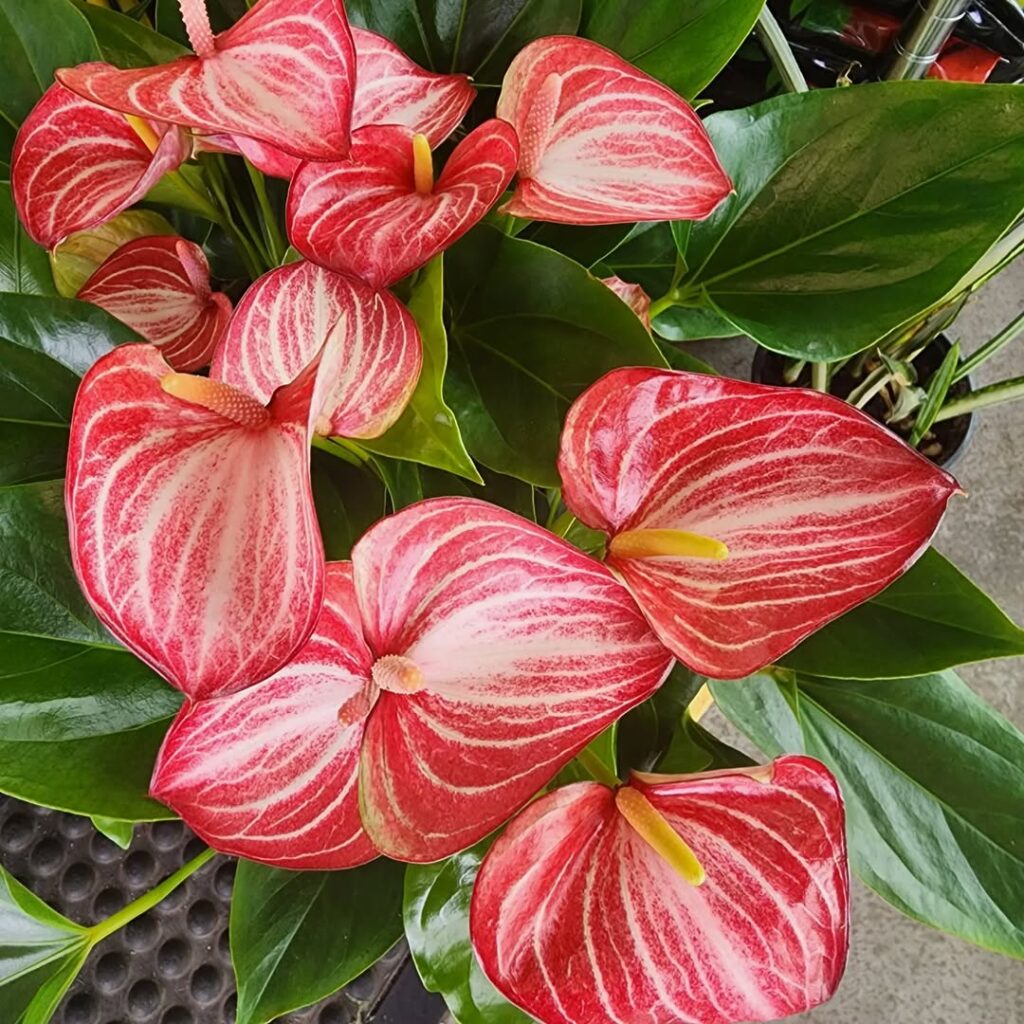
Anthurium Andraeanum is one of the most popular species, often seen in homes and offices. It produces striking, waxy flowers in shades of red, pink, white, and even purple. The heart-shaped leaves are glossy and deep green, adding to its elegant look. This species thrives indoors, needing bright, indirect light and moderate humidity to keep its iconic blooms vibrant.
2. Anthurium Clarinervium
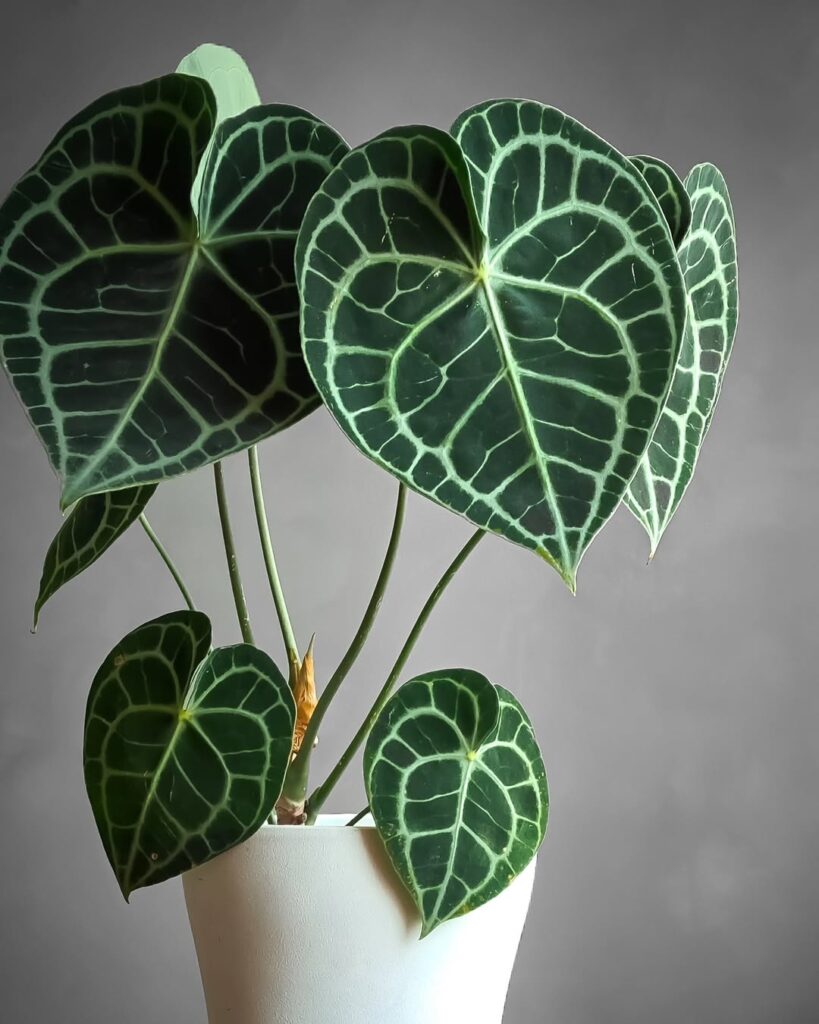
Anthurium Clarinervium is all about its bold, velvety foliage. Its dark green leaves are oversized, with dramatic white veins spreading out like lightning bolts. The texture is thick and leathery, making it stand out among Anthurium varieties. Unlike Andraeanum, Clarinervium isn’t prized for its flowers—it’s grown for its stunning leaves that can reach over a foot wide.
3. Anthurium Scherzerianum (Pigtail Anthurium)
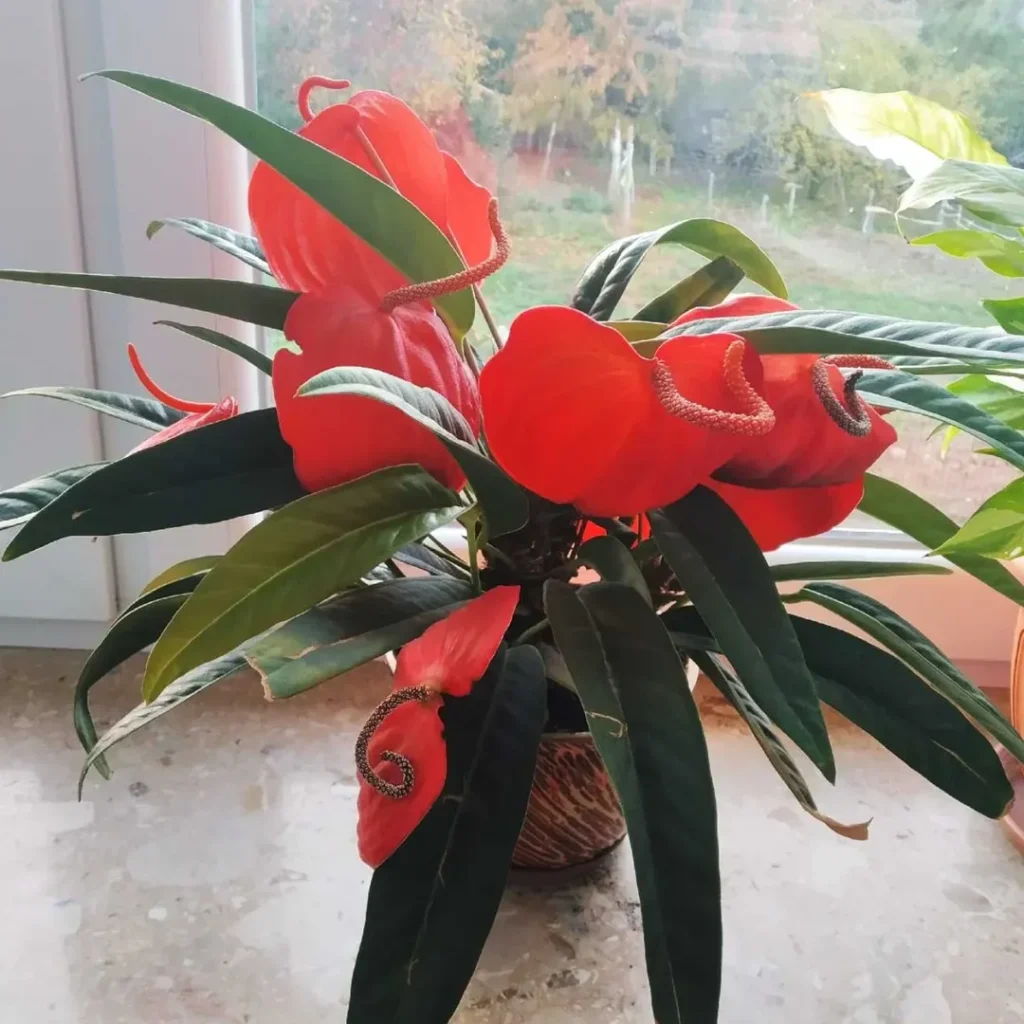
Anthurium Scherzerianum takes a quirky approach to Anthurium flowers—it has a curly, twisted spadix, making it look completely different from the smooth, structured spadix of other species. Its blooms come in fiery shades of orange, red, and yellow, adding warmth to any indoor space. This species is one of the easiest Anthuriums to grow, tolerating a variety of conditions.
4. Anthurium Warocqueanum (Queen Anthurium)
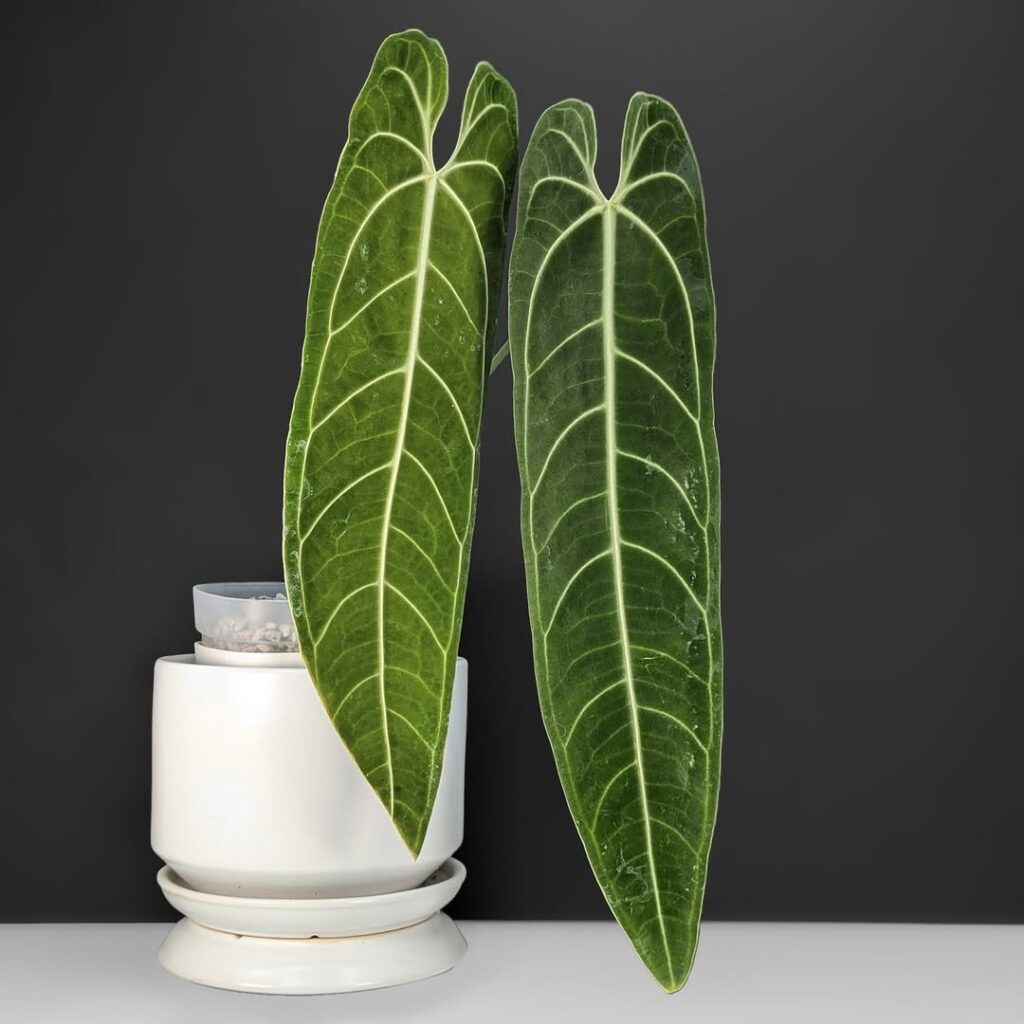
Anthurium Warocqueanum earns its regal name thanks to its enormous, elongated leaves, which can grow several feet long indoors. The velvety dark green foliage is accented with thick white veins, giving it an otherworldly appearance. This species thrives in high humidity and warm conditions, making it a challenge—but a rewarding one—for indoor plant collectors.
5. Anthurium Veitchii (King Anthurium)
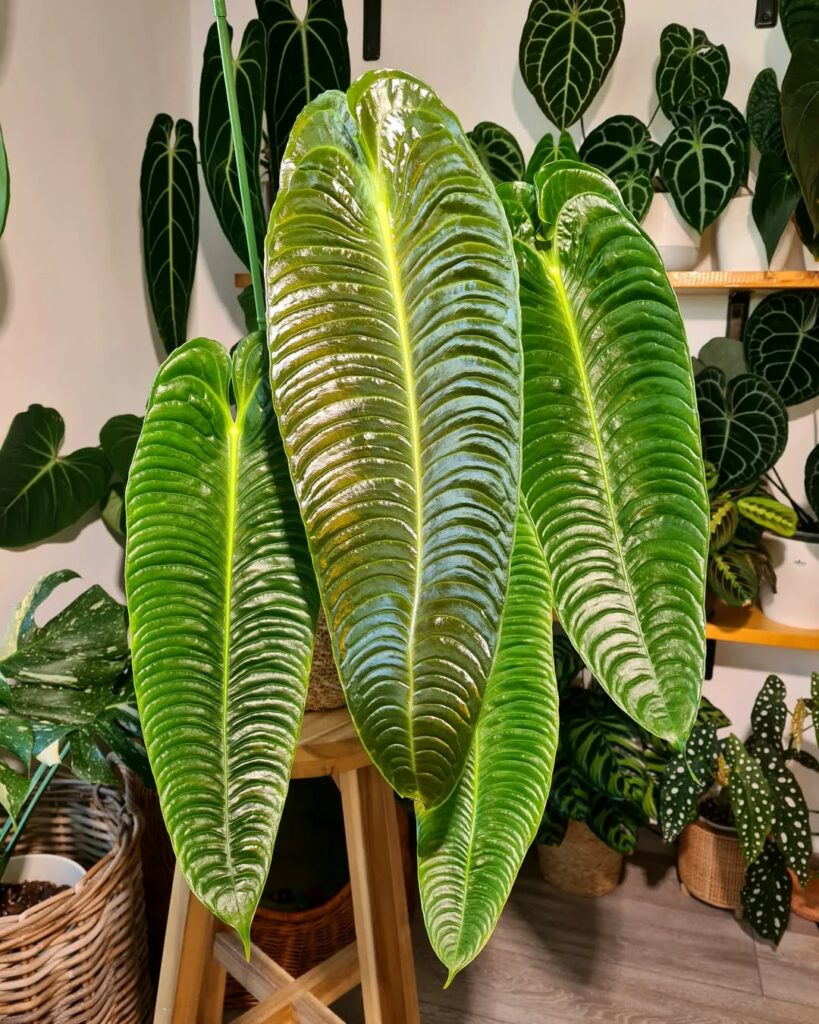
Anthurium Veitchii is known as the King Anthurium due to its long, rippling leaves. Unlike the smooth texture of most species, its foliage has dramatic pleats, making it look sculptural. It’s a slow grower but a true showstopper when mature, demanding patience and consistent humidity.
6. Anthurium Magnificum
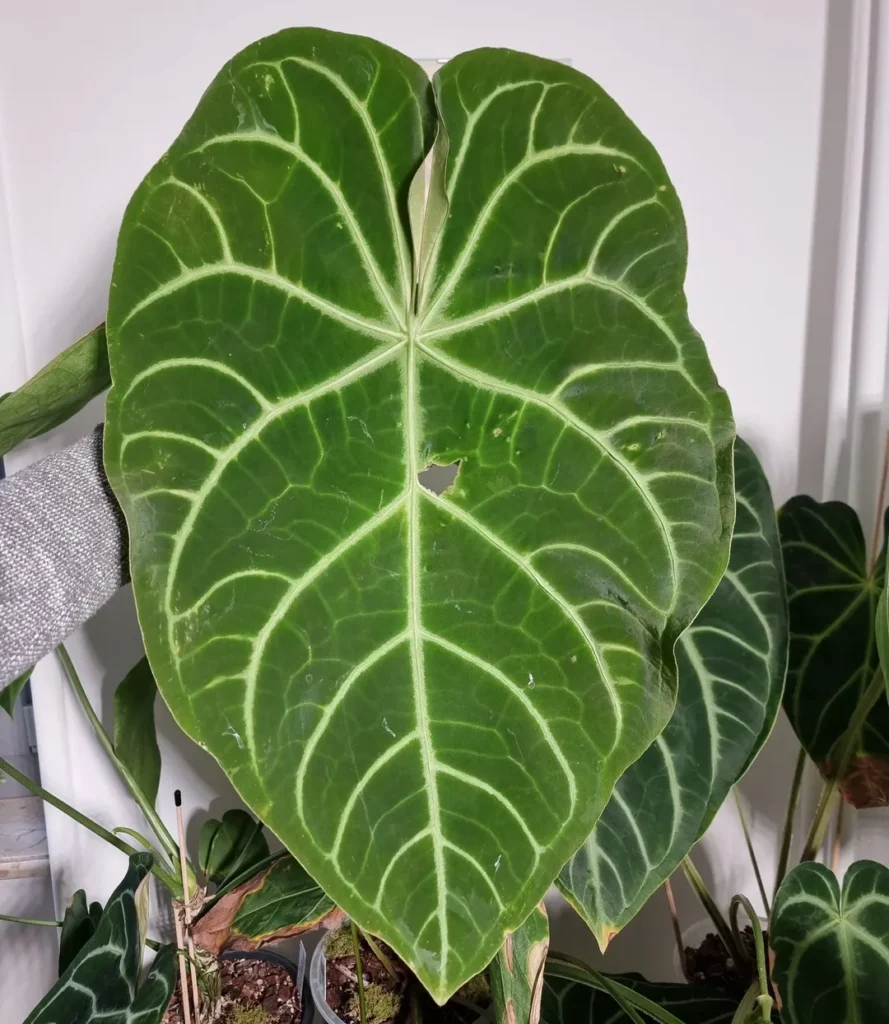
Anthurium Magnificum is true to its name—its leaves are huge, round, and deeply veined, making them look grand and luxurious. Unlike the Queen and King Anthuriums, Magnificum has a more structured, symmetrical leaf shape, giving it a polished appearance. It requires warm temperatures and bright indirect light to maintain its striking foliage.
7. Anthurium Regale
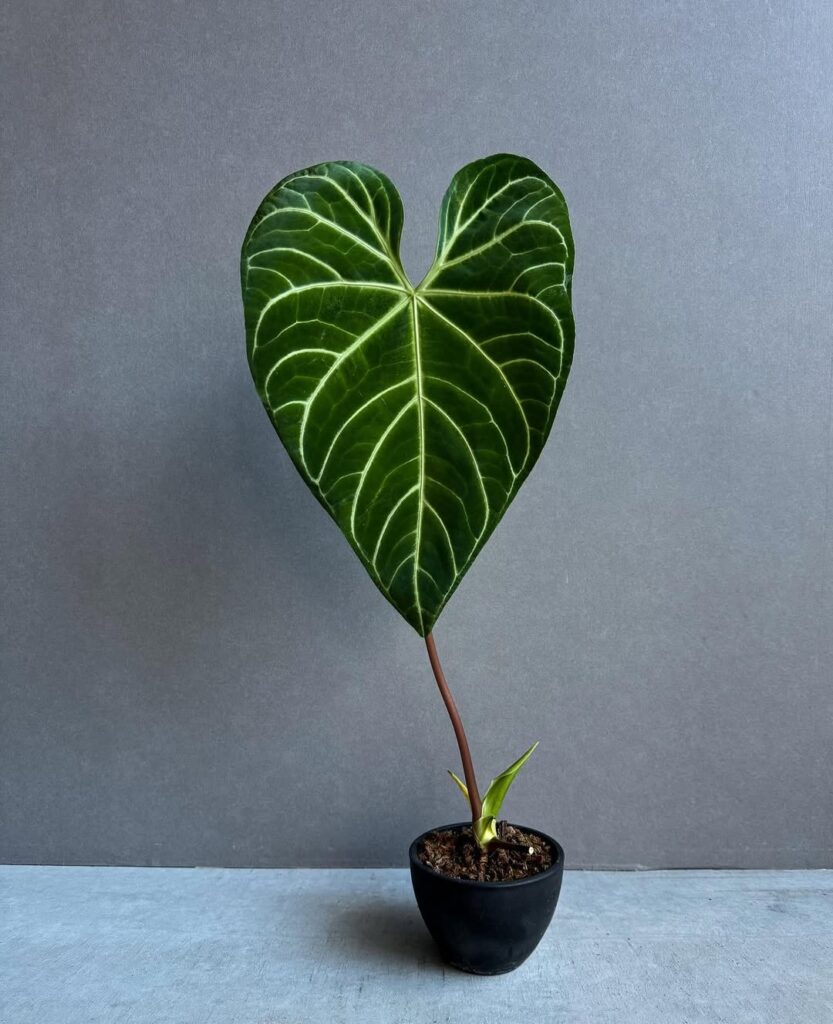
Anthurium Regale is one of the largest-leaved Anthuriums, with mature leaves reaching over three feet long! The velvety green surface is marked with white veins, creating a stunning contrast. This species needs extra-large space and plenty of humidity to thrive, making it a prized plant for serious collectors.
8. Anthurium Forgetii
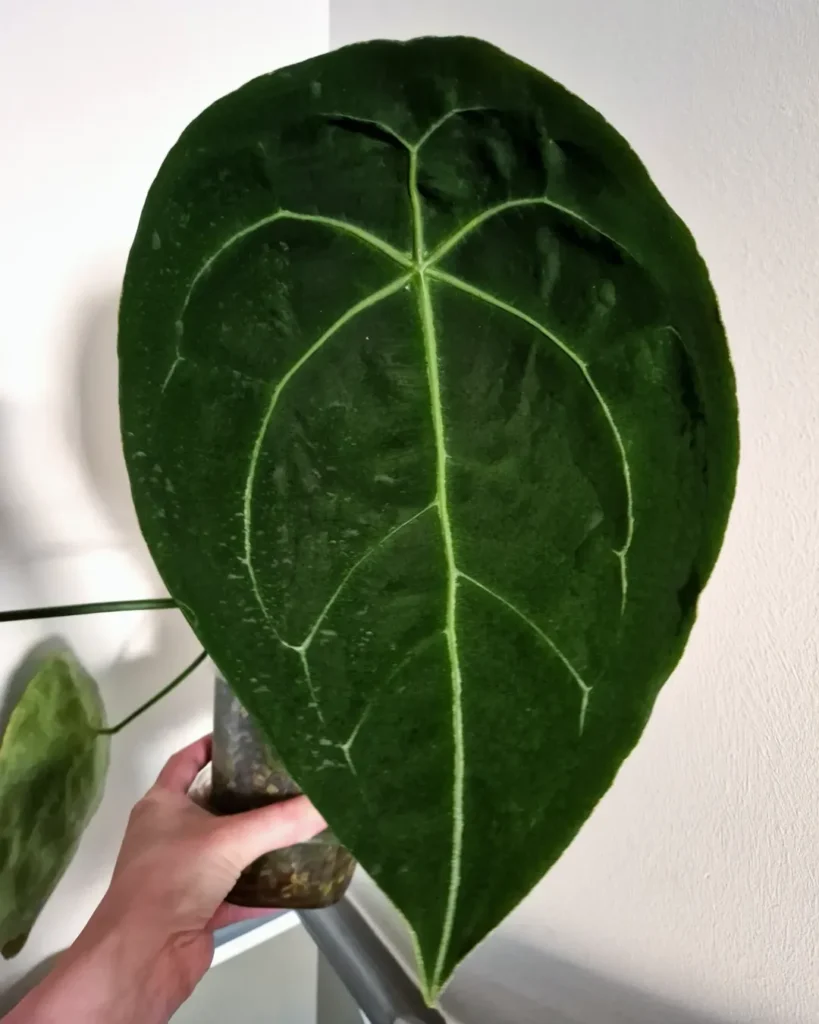
Anthurium Forgetii is unique because it lacks a sinus—that small notch typically found at the top of Anthurium leaves. Instead, its foliage is perfectly round, giving it a teardrop shape that looks delicate and refined. It’s a compact species, making it ideal for terrariums or small indoor setups.
9. Anthurium Crystallinum

Anthurium Crystallinum is often compared to Clarinervium, but it has thinner, more delicate leaves. Its veins shimmer with silvery-white hues, creating a gorgeous contrast against the dark green background. It thrives in high humidity, making it perfect for bathrooms or indoor greenhouse setups.
10. Anthurium Vittarifolium
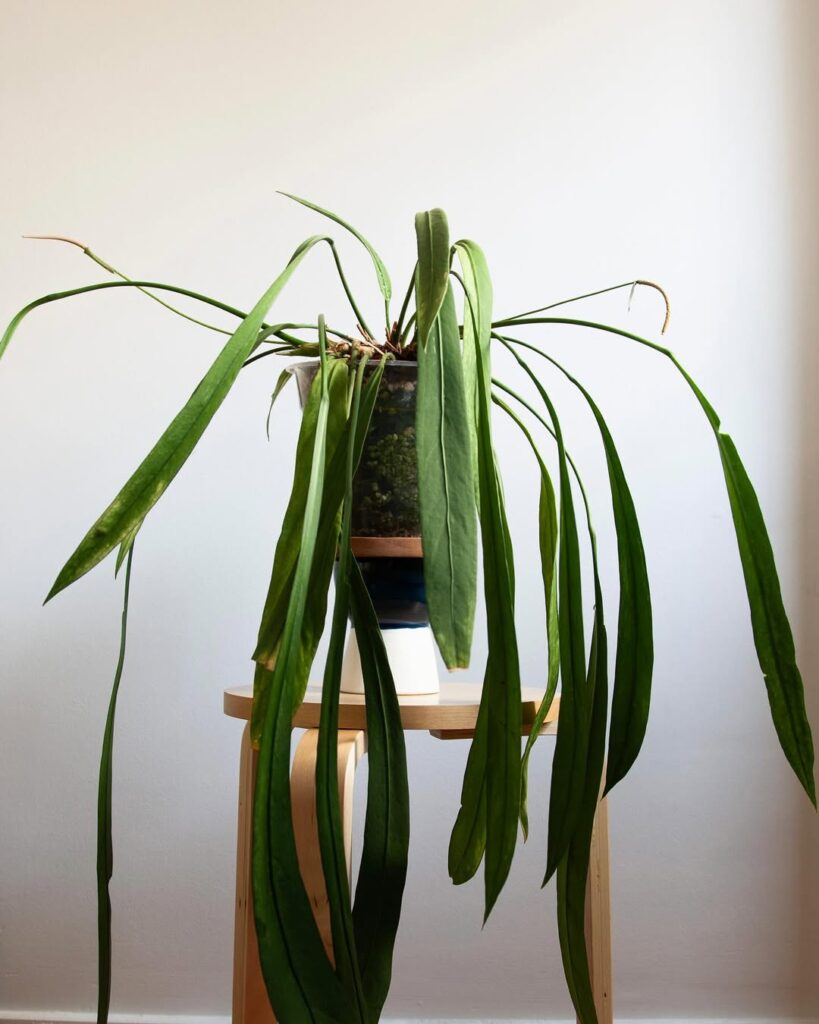
Anthurium Vittarifolium is unlike most Anthuriums—it has long, strap-like leaves that gracefully hang down rather than growing upright. This makes it perfect for hanging baskets, adding a tropical touch to indoor spaces. Its leaves can grow several feet long, cascading beautifully over the edges of containers.
11. Anthurium Luxurians
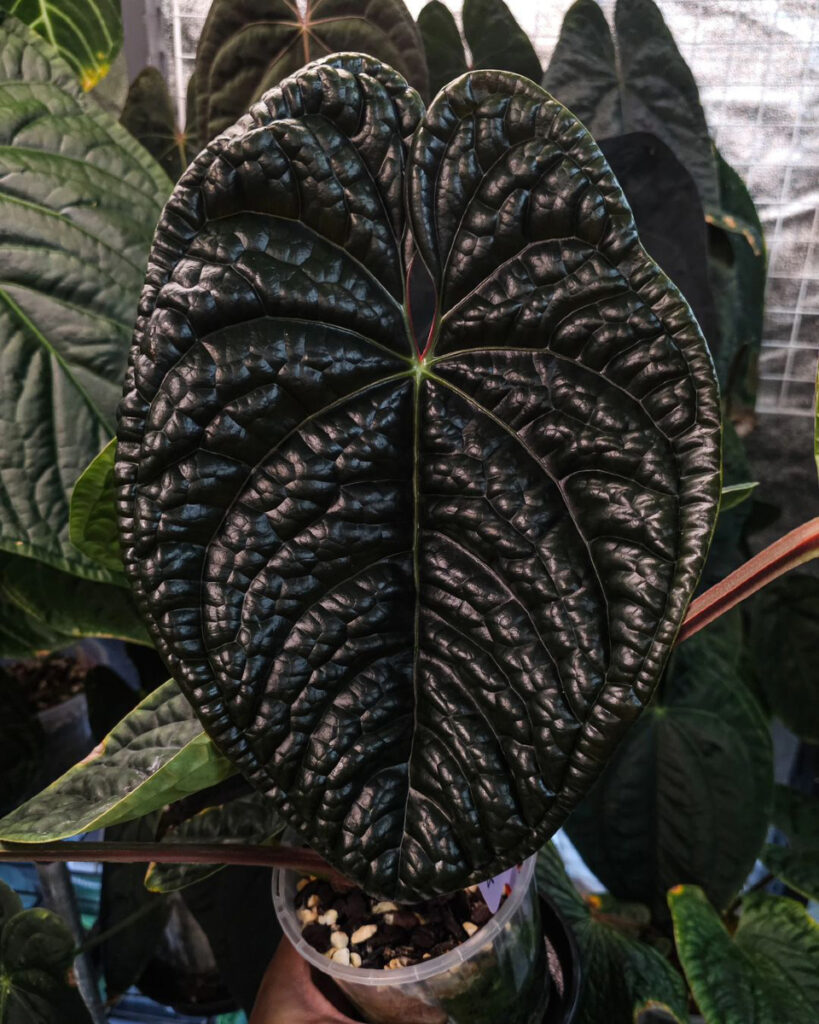
Anthurium Luxurians has deeply textured leaves with a glossy, almost metallic finish. The veins create a quilted look, making it appear elegant and futuristic. Unlike velvety Anthuriums, Luxurians has a rigid, glossy texture, standing out in a collection.
12. Anthurium Pallidiflorum
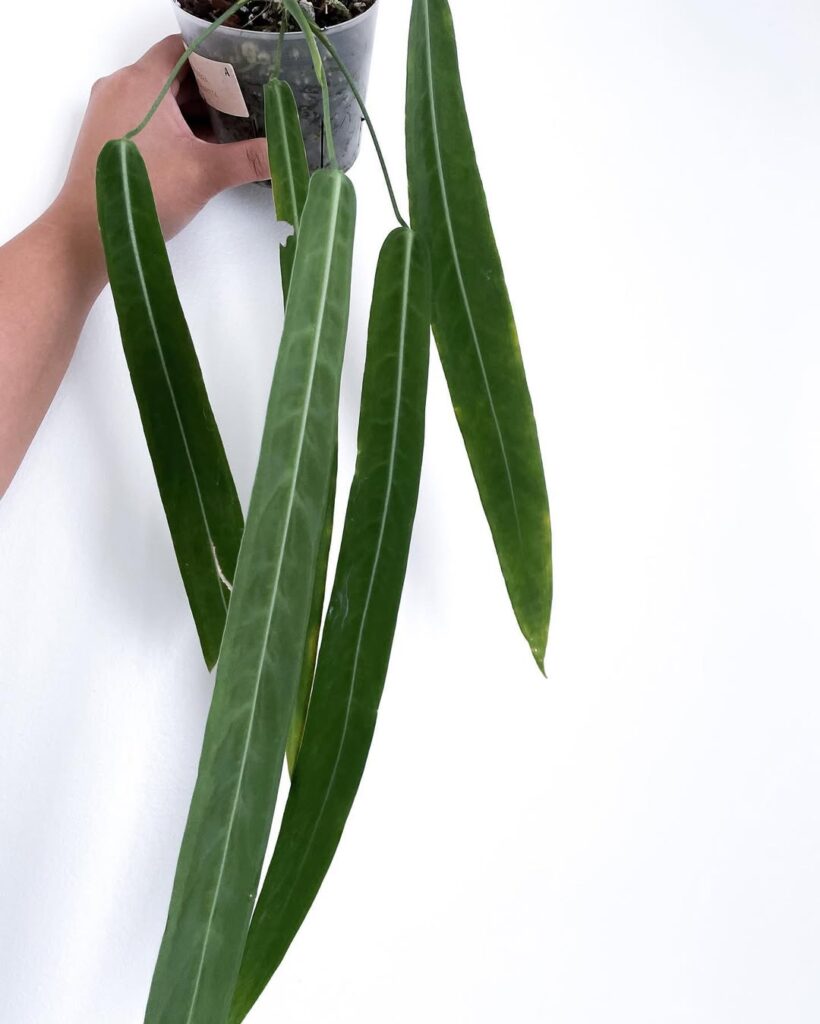
Anthurium Pallidiflorum is a soft, delicate variety, with slender leaves that feel almost like silk. Its subtle beauty makes it a great contrast to the bold-leaved varieties. It needs high humidity and gentle care to maintain its fragile charm.
13. Anthurium Radicans
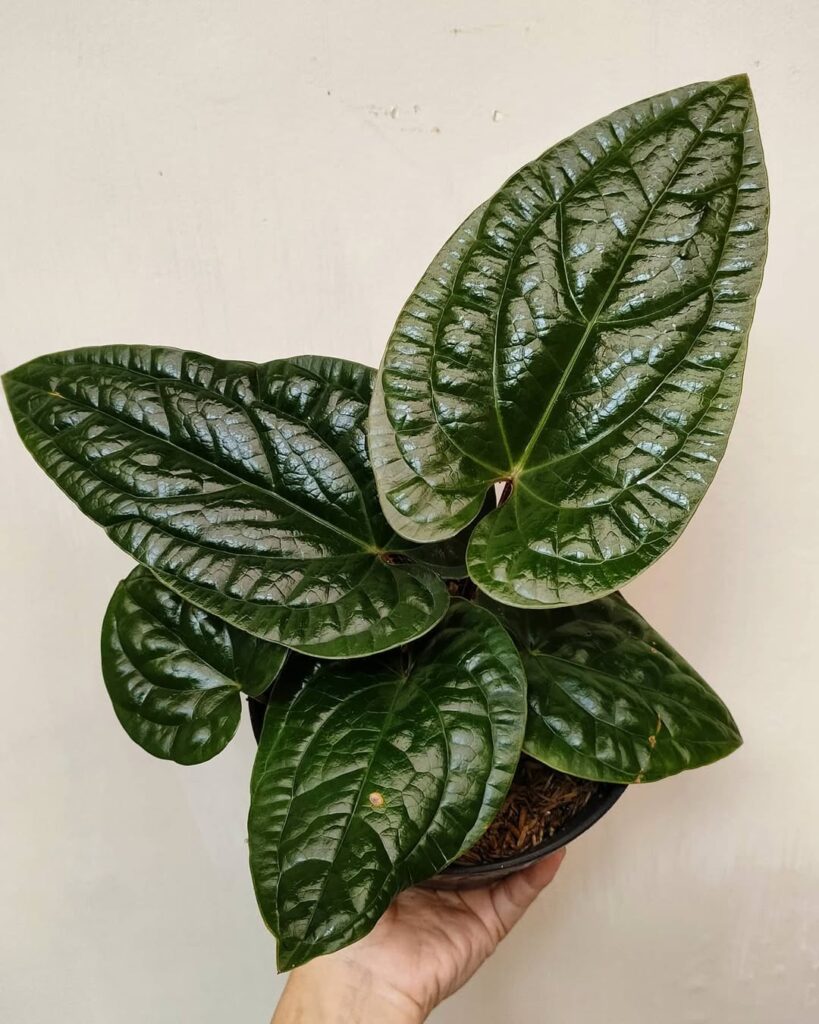
Anthurium Radicans has a creeping growth habit, meaning it spreads along the soil rather than growing upright. Its thick, leathery leaves hug the ground, making it a great choice for wide pots or ground cover in tropical gardens.
14. Anthurium Wendlingeri
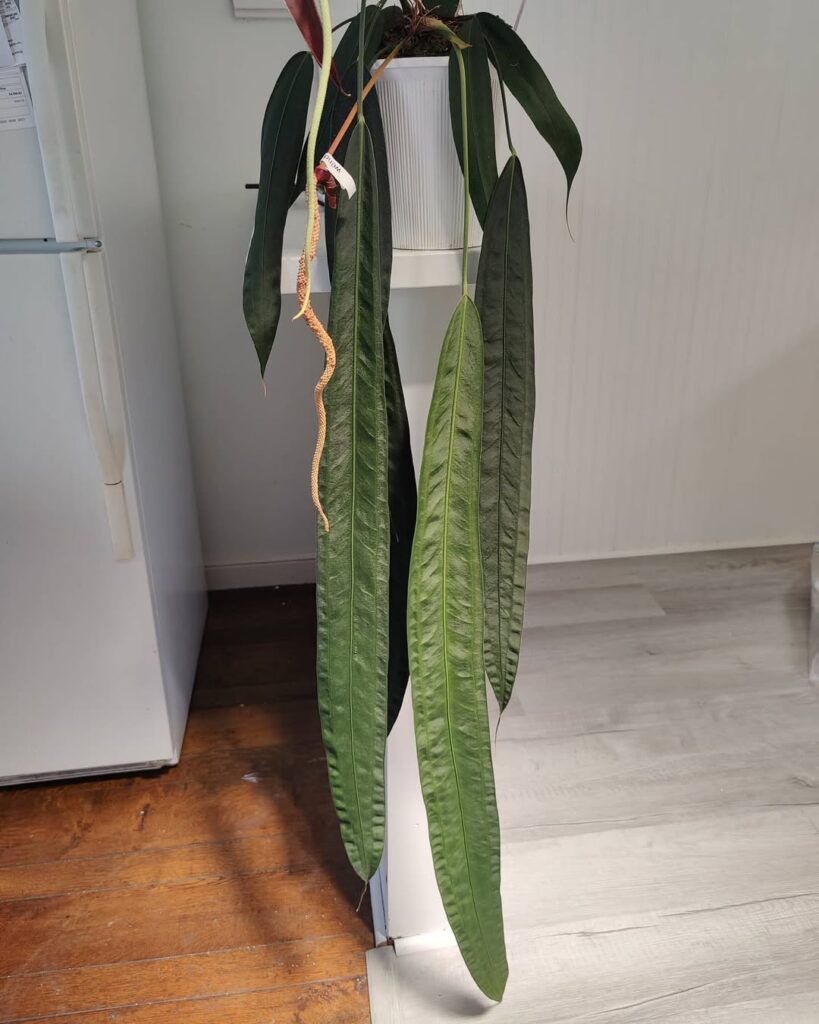
Anthurium Wendlingeri is famous for its spiral-shaped spadix, giving it an exotic look. Unlike typical Anthurium flowers, this one grows in a twisted form, creating visual interest.
15. Anthurium Plowmanii
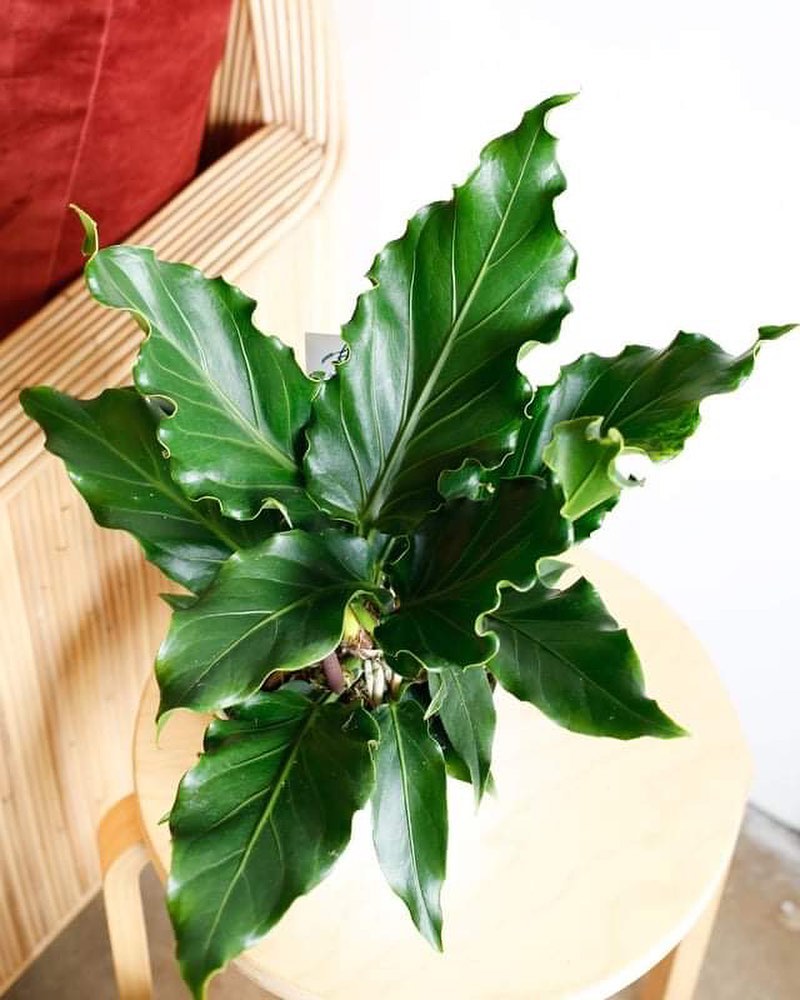
Anthurium Plowmanii has wavy-edged leaves that ripple like ocean waves. It’s one of the tougher Anthuriums, tolerating drier conditions better than most.
16. Anthurium Cobra
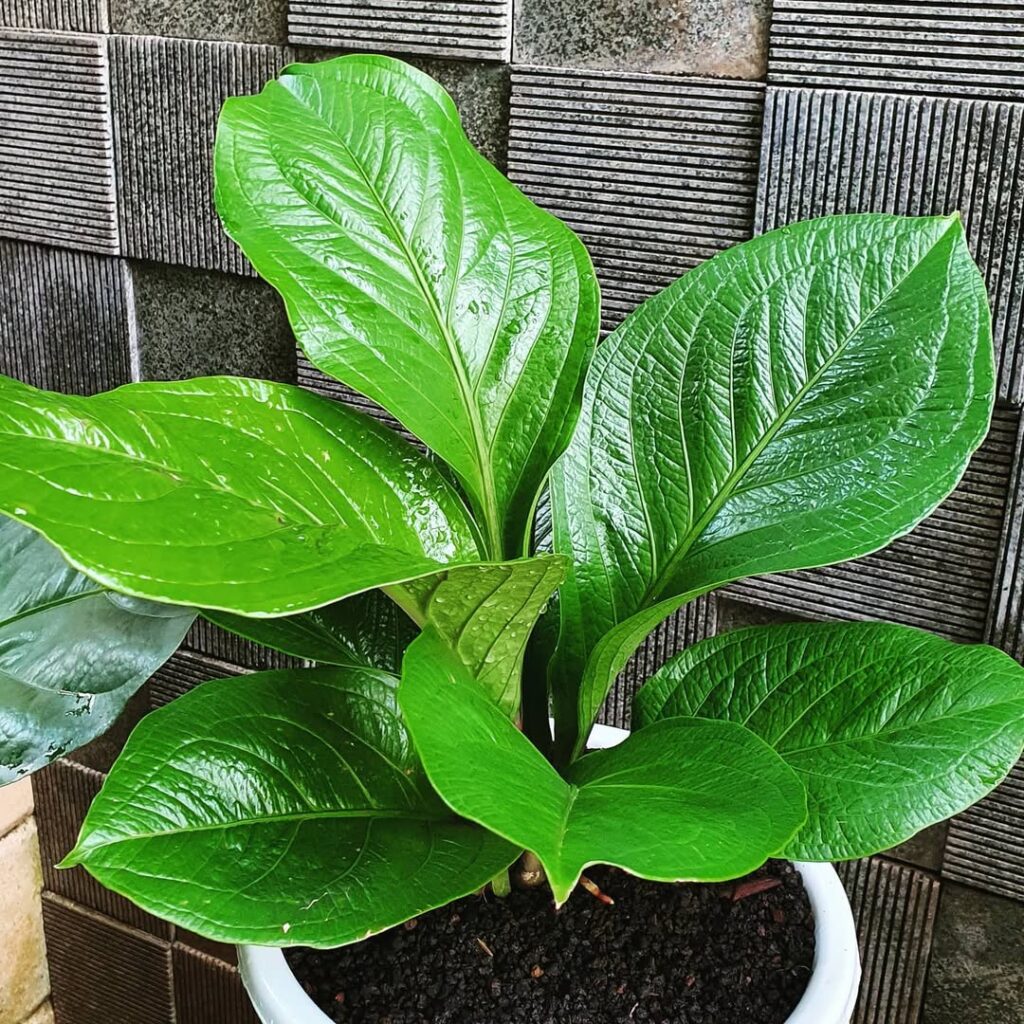
Anthurium Cobra is a bold, upright variety, with thick, rigid leaves that can grow several feet tall. It adds vertical drama to any collection.
17. Anthurium Metallicum
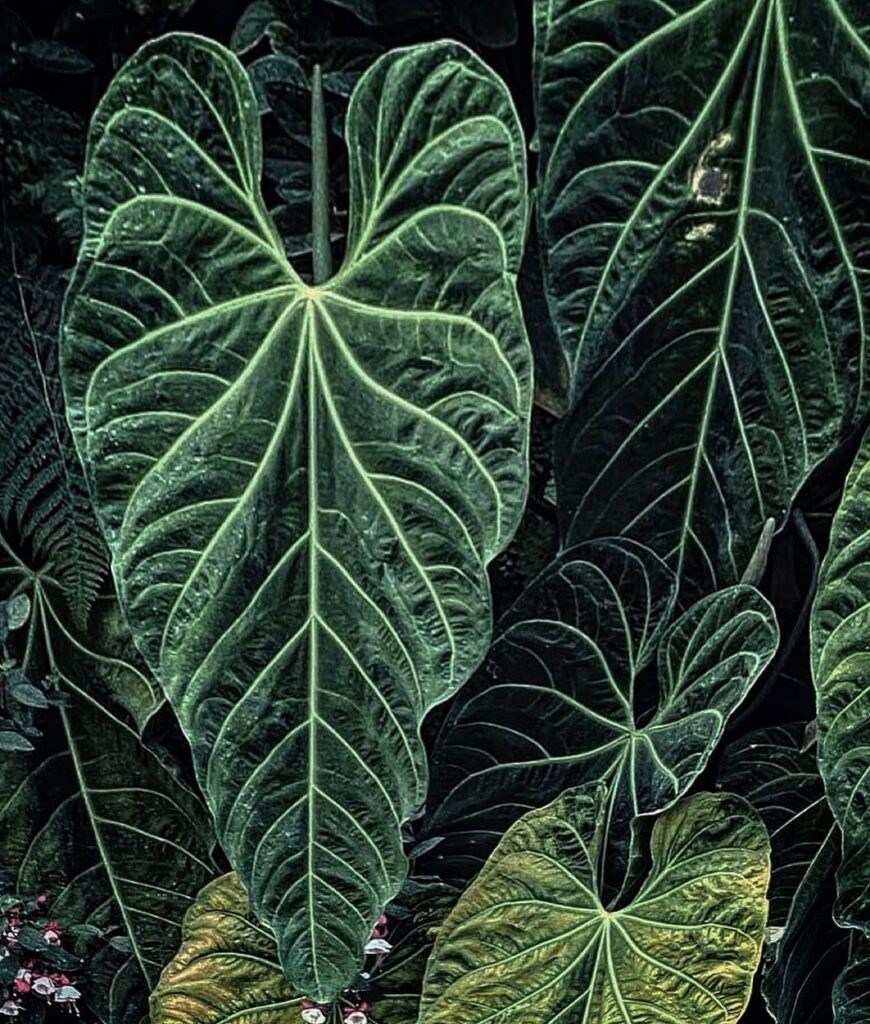
Anthurium Metallicum has a unique metallic sheen, making it appear futuristic and elegant.
18. Anthurium Papillilaminum
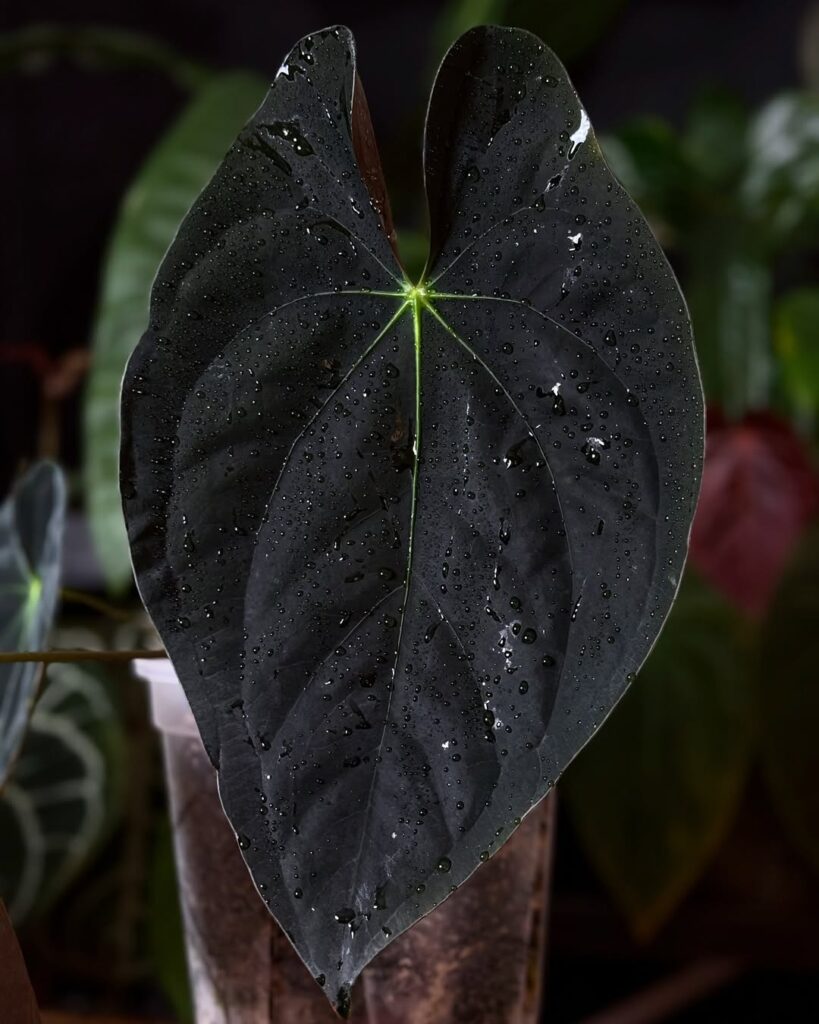
Anthurium Papillilaminum is known for its dark, velvety leaves with stunning contrast.
19. Anthurium Jenmanii
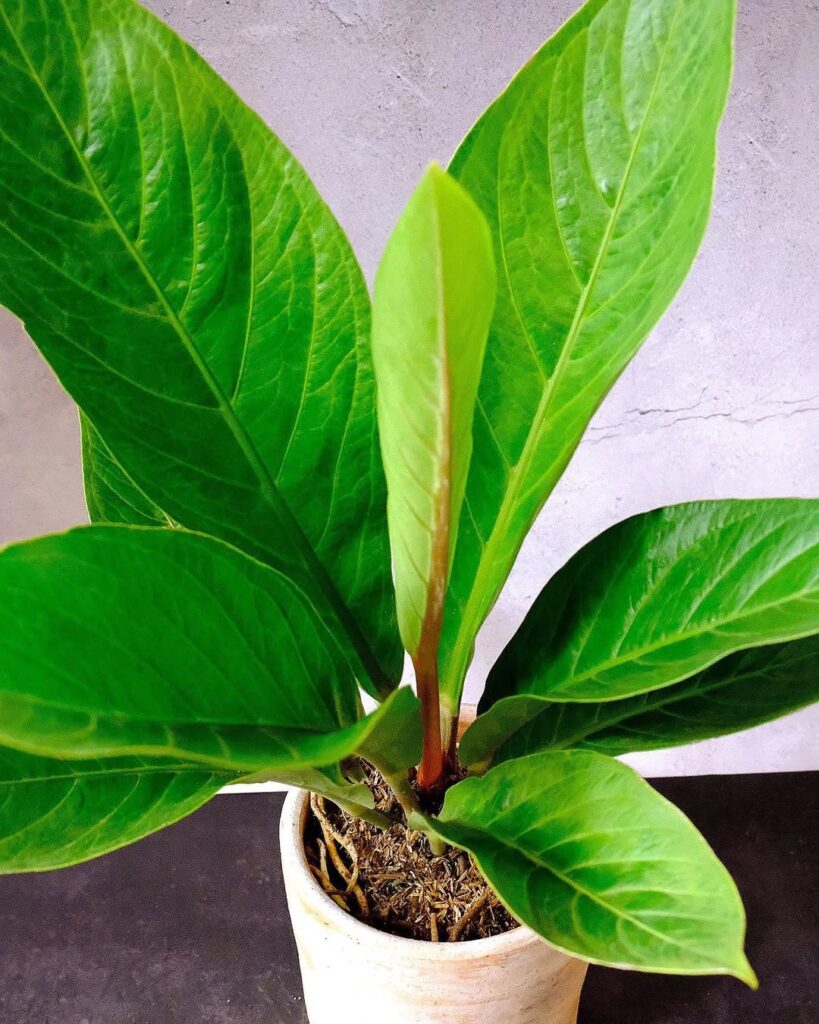
Anthurium Jenmanii has sculptural, upright leaves, making it one of the more structured Anthuriums.
20. Anthurium Pendulifolium
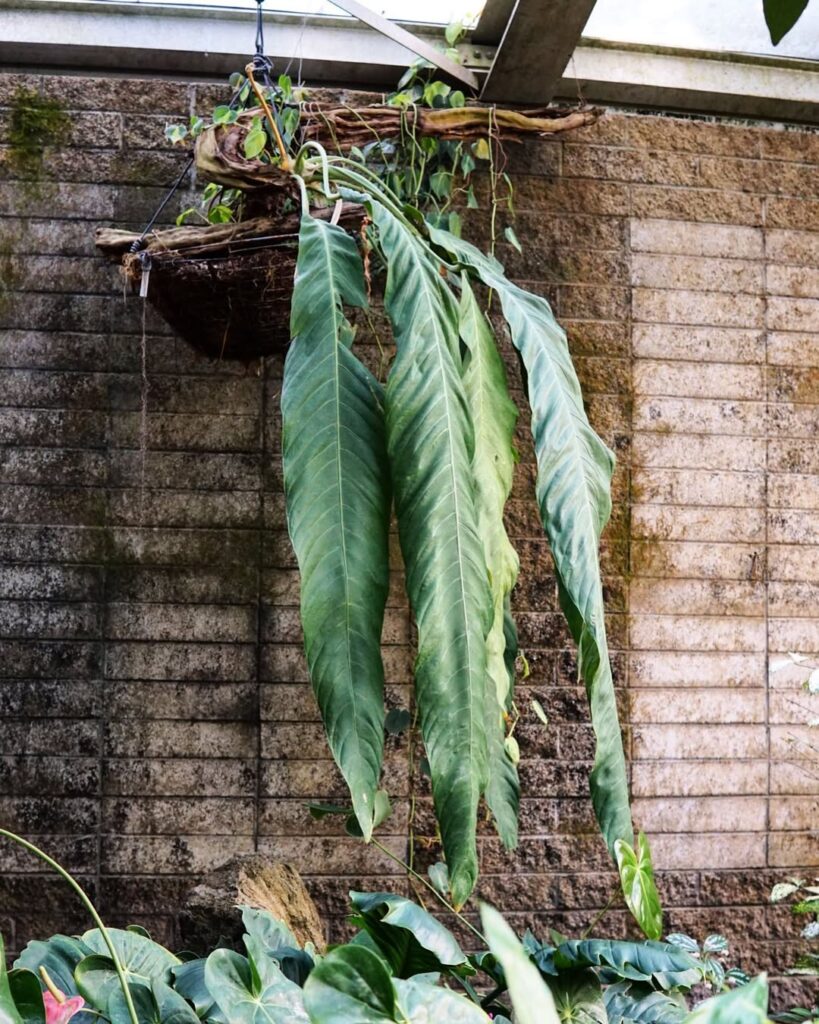
Anthurium Pendulifolium has ribbon-like leaves that hang gracefully, making it ideal for vertical gardening.
21. Anthurium Balaoanum
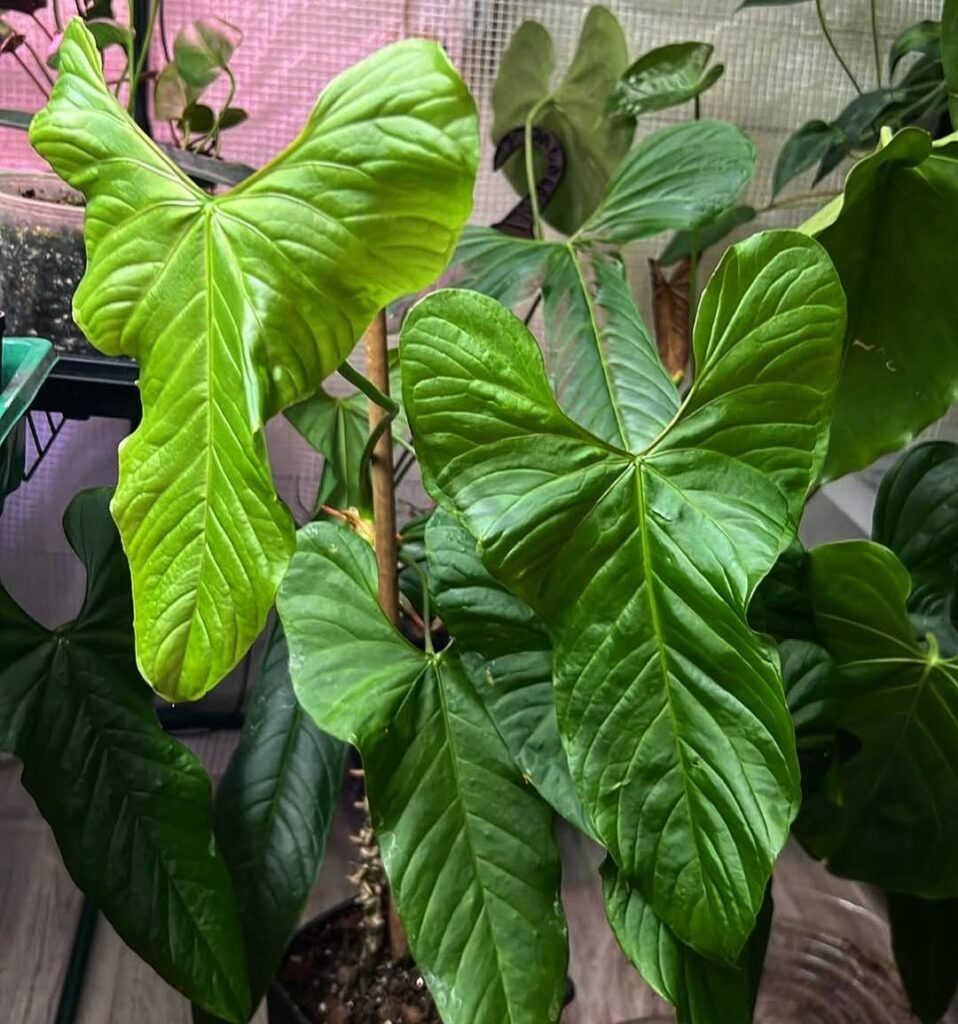
Anthurium Balaoanum (syn. Anthurium Dussi) features massive paddle-shaped leaves, creating a tropical vibe indoors.
22. Anthurium Corrugatum
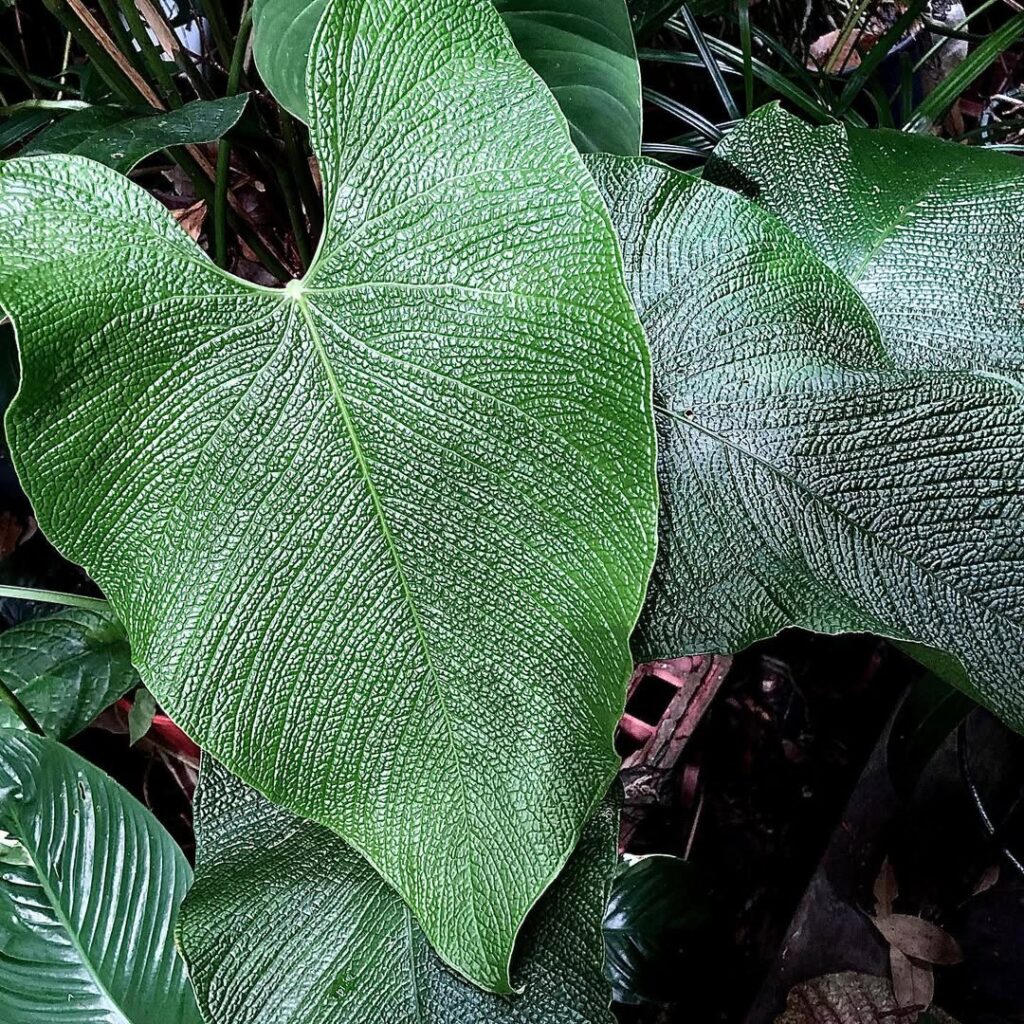
Anthurium Corrugatum stands out with its deeply crinkled leaves, adding texture to a collection.
23. Anthurium Rugulosum
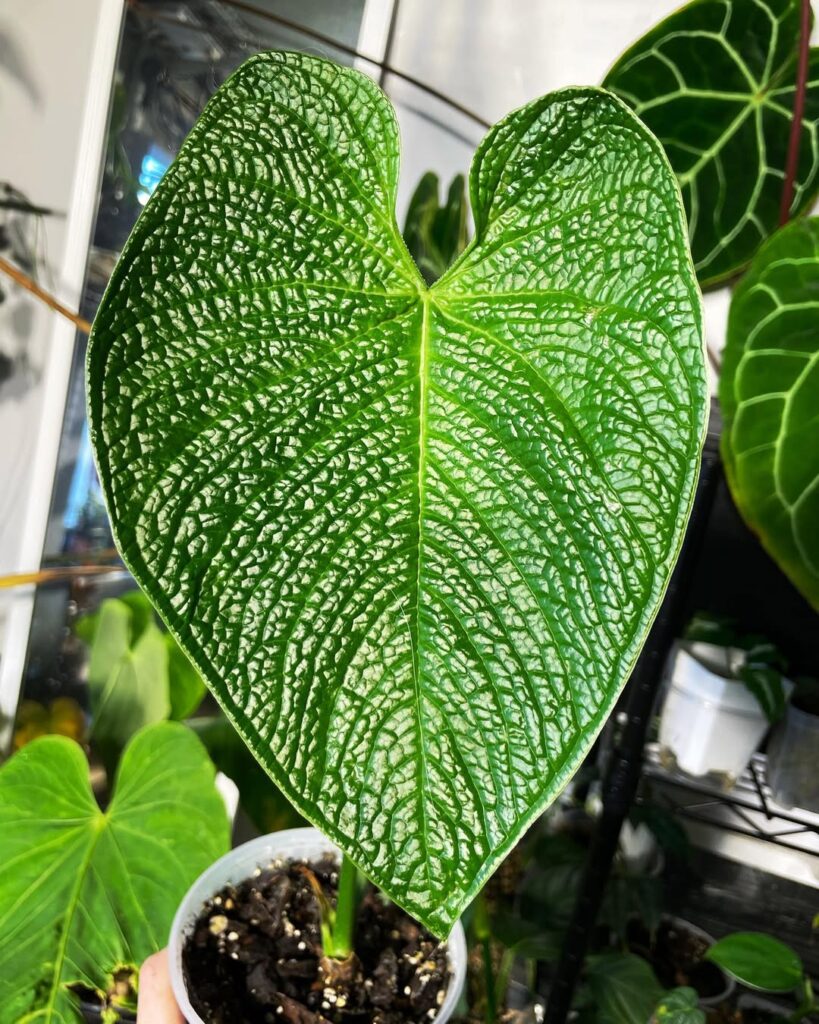
Anthurium Rugulosum has leathery, wrinkled leaves, making it a rare and fascinating find.
24. Anthurium Cutucuense
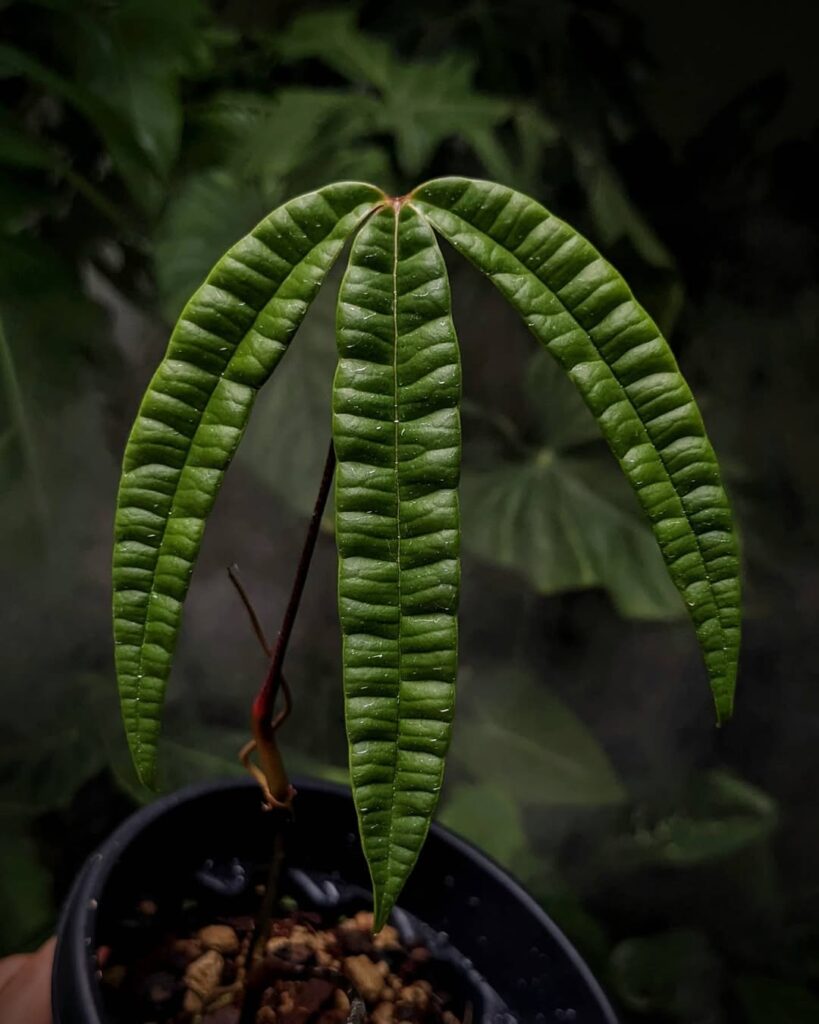
Anthurium Cutucuense has thin, elongated leaves, giving it an almost alien-like appearance.
25. Anthurium Ace of Spades
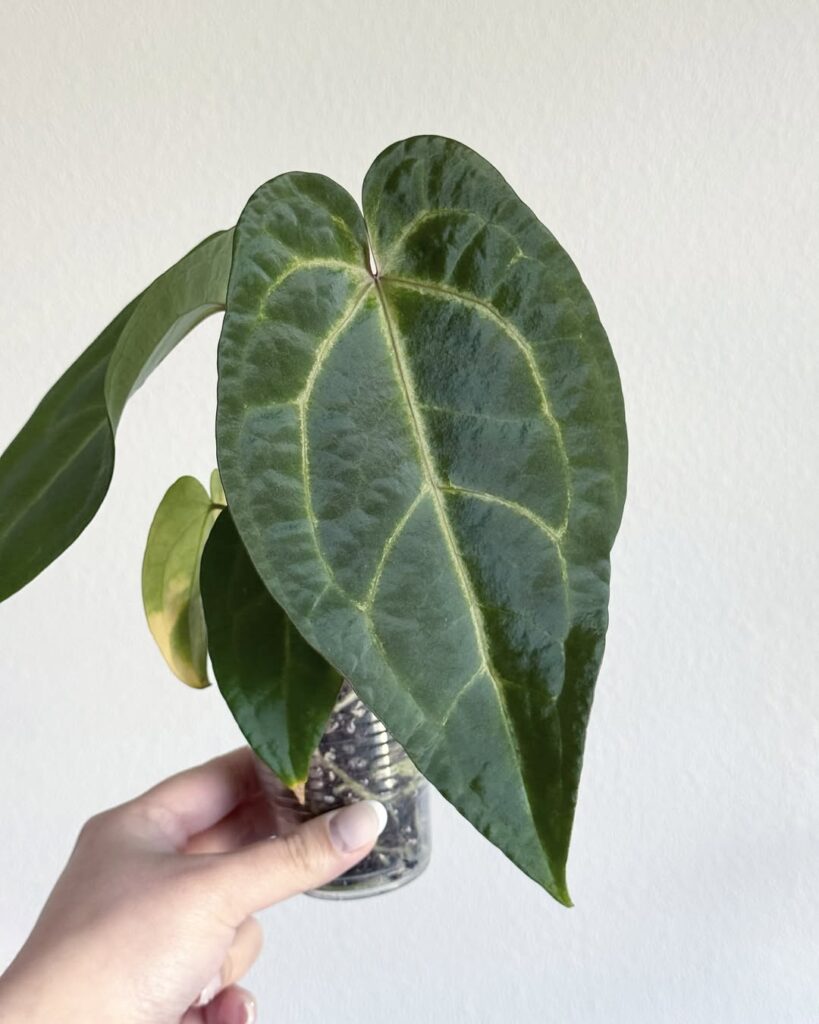
Anthurium Ace of Spades is a dramatic, dark green variety with almost black-toned foliage.
26. Anthurium Splendidum
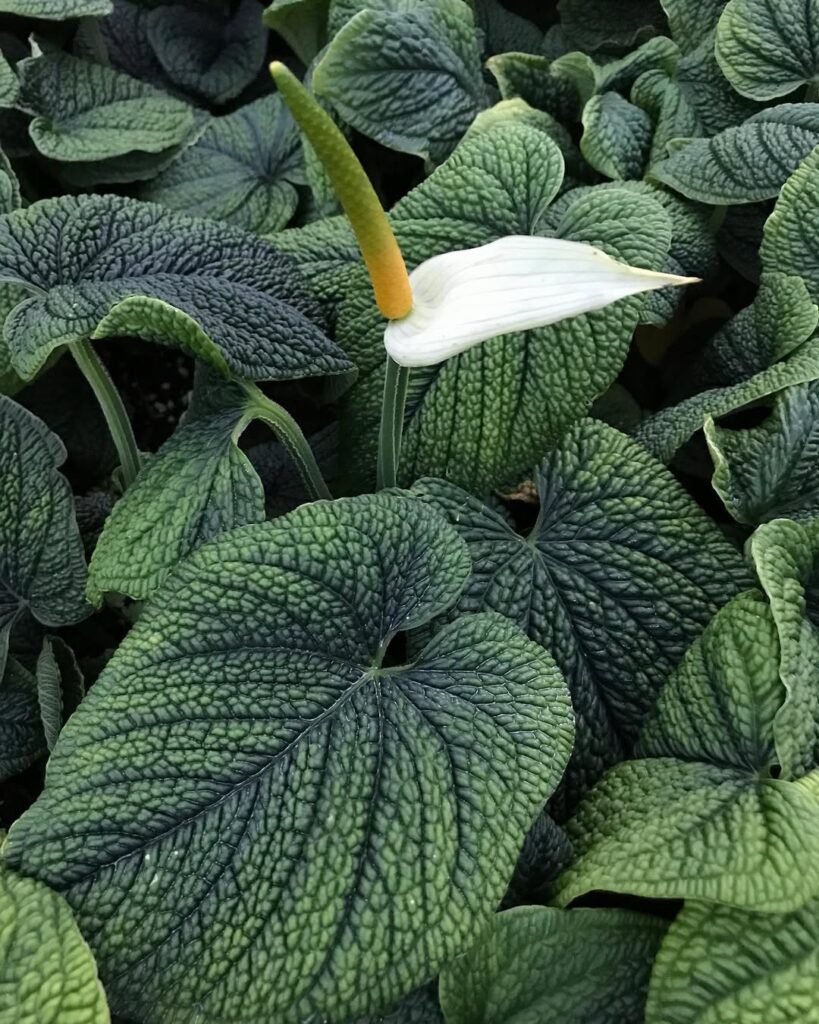
Anthurium Splendidum is a rare species with thick, textured leaves covered in small bumps, giving it a reptilian appearance. It thrives in high humidity and is a prized collector’s plant.
27. Anthurium Hookeri (Bird’s Nest Anthurium)
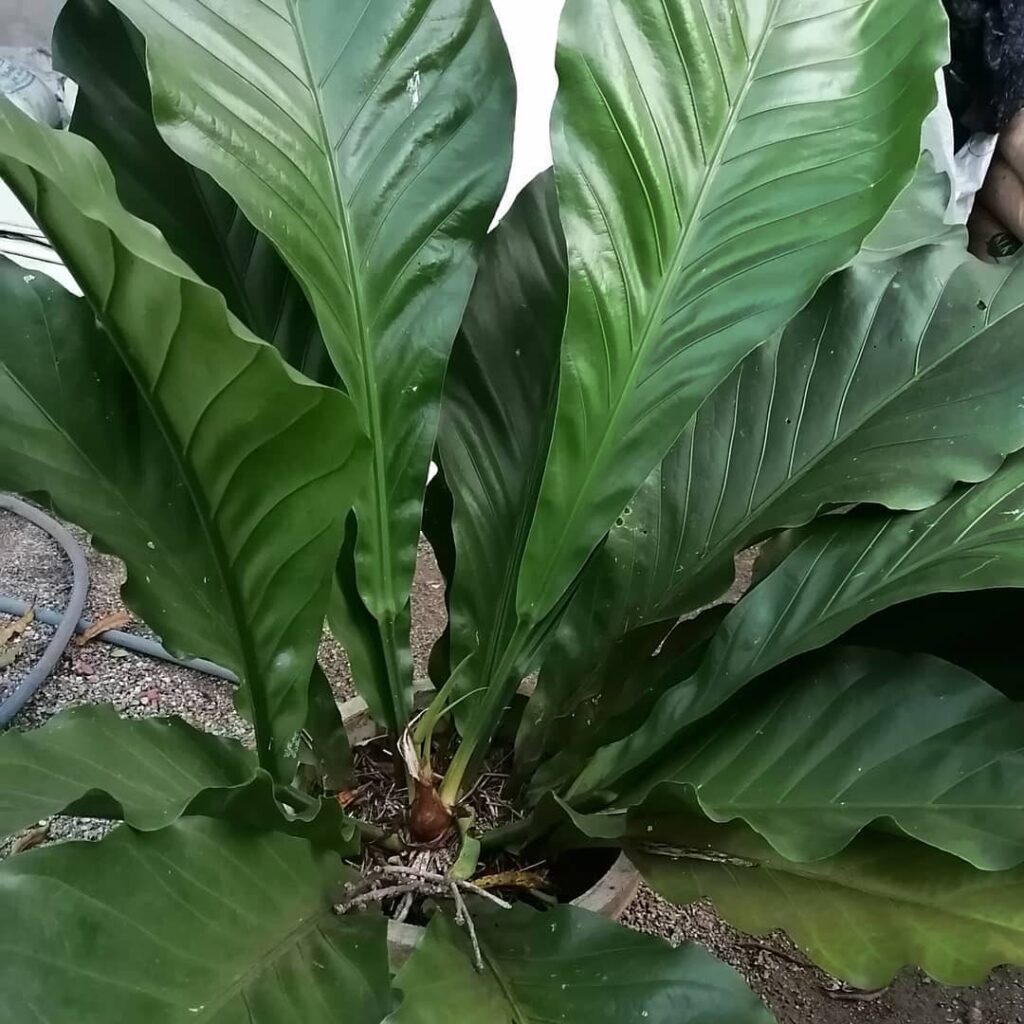
Anthurium Hookeri (also Anthurium Cubense) has broad, wavy leaves that grow in a rosette shape, resembling a bird’s nest. It’s a low-maintenance variety that adapts well to indoor conditions.
28. Anthurium Bullatus
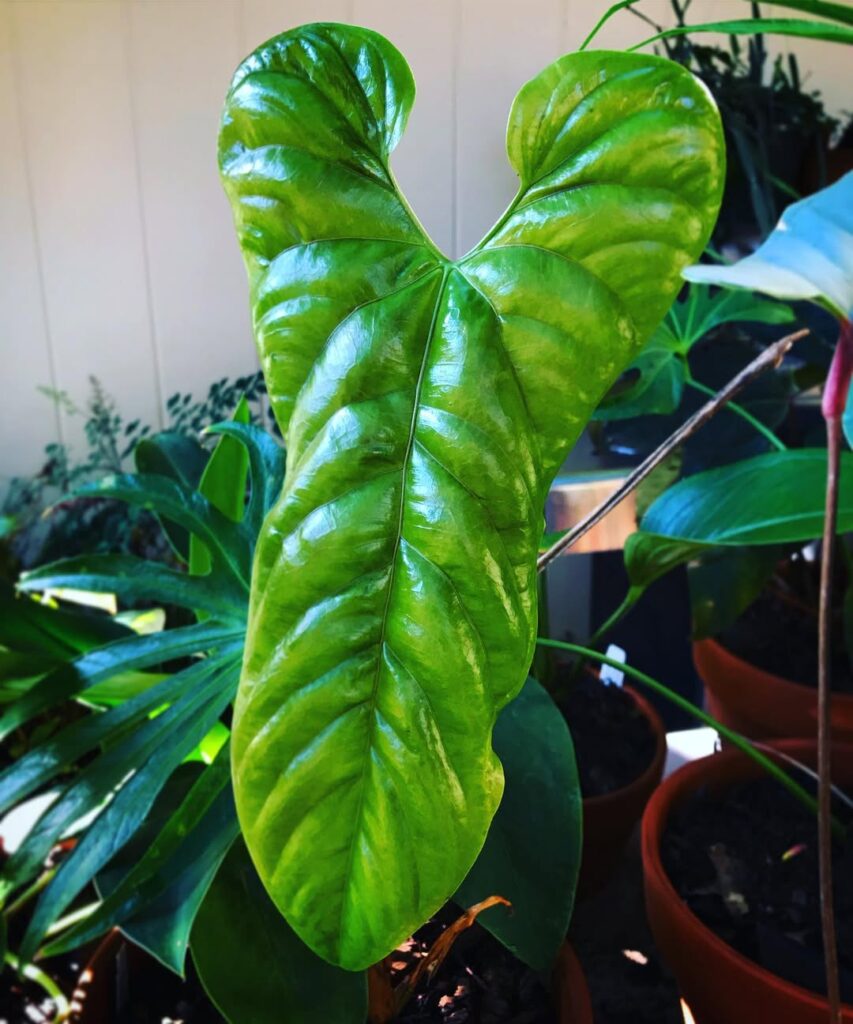
Anthurium Bullatus has deeply ridged leaves that look almost accordion-like. Its unique texture makes it a standout in any plant collection.
29. Anthurium Pendens
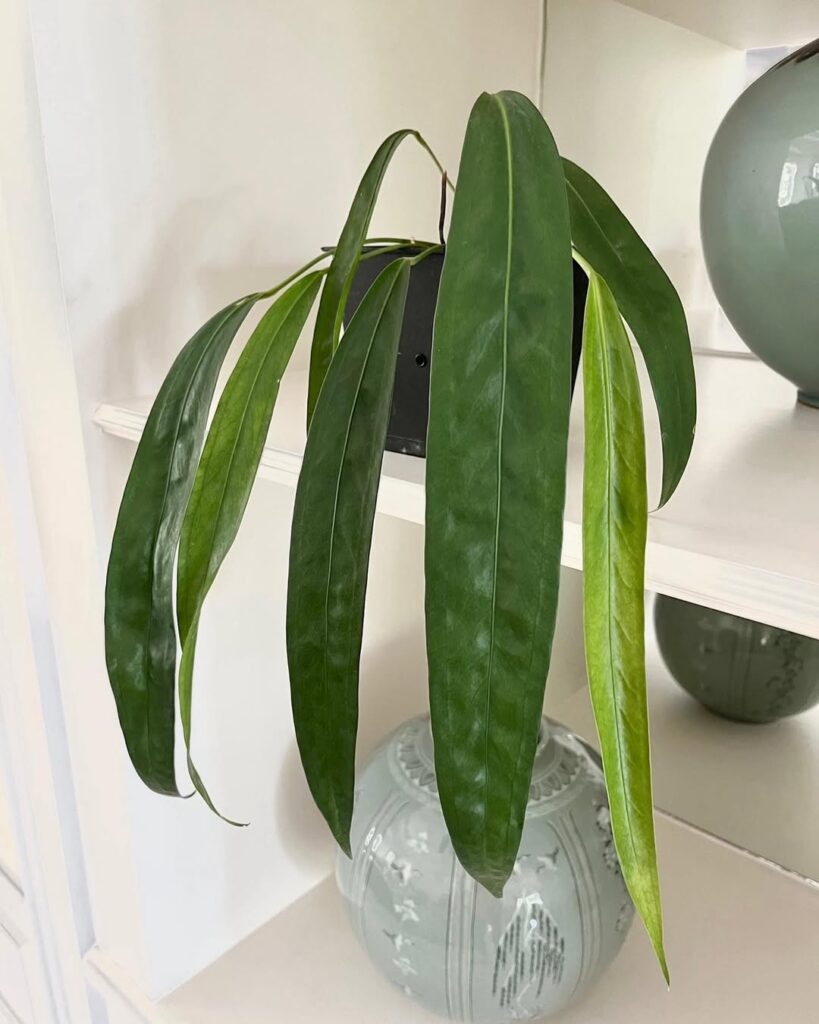
Anthurium Pendens is a trailing variety with long, slender leaves that cascade down, making it perfect for hanging baskets.
30. Anthurium Polyschistum
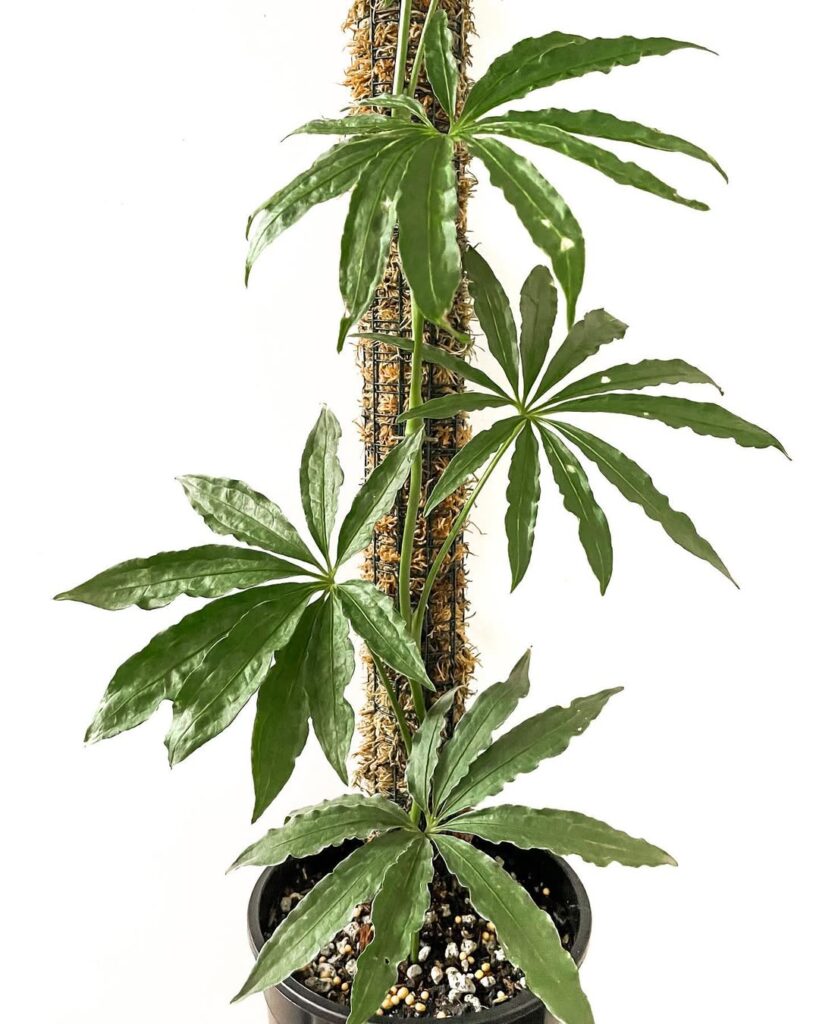
Anthurium Polyschistum is a vining epiphyte with palm-like leaves, giving it a tropical jungle vibe.
31. Anthurium Decipiens
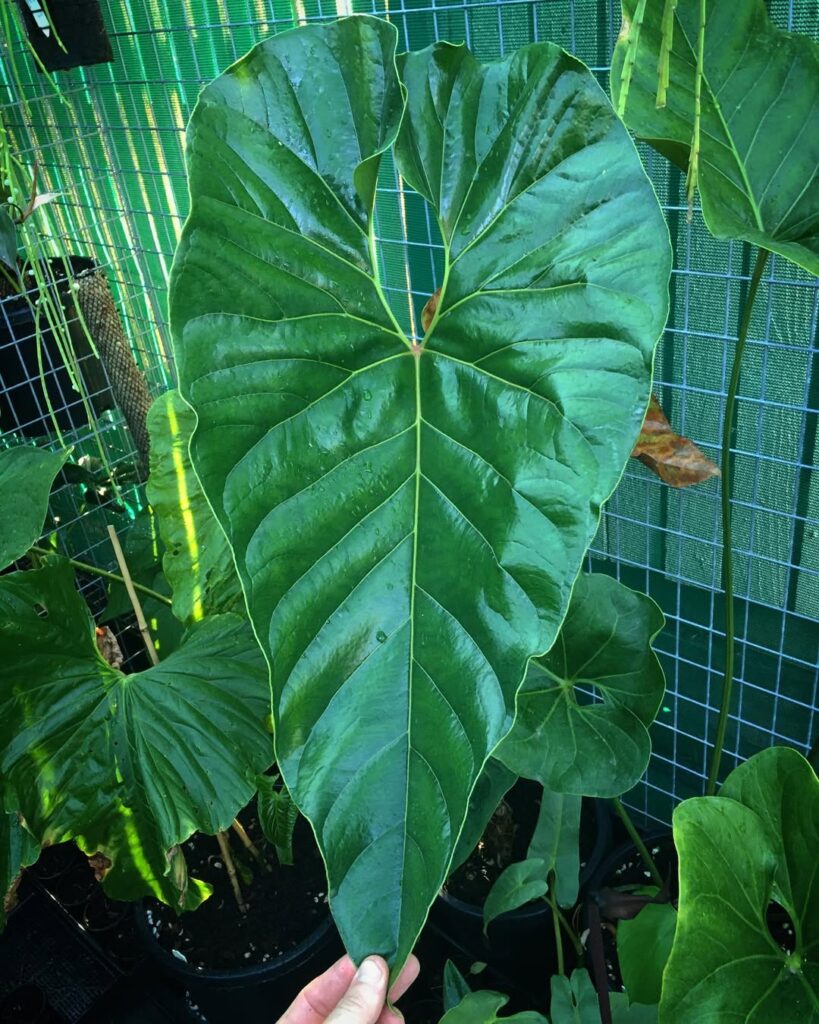
Anthurium Decipiens has large, paddle-shaped leaves with a glossy finish, making it a striking addition to indoor spaces.
32. Anthurium Schlechtendalii
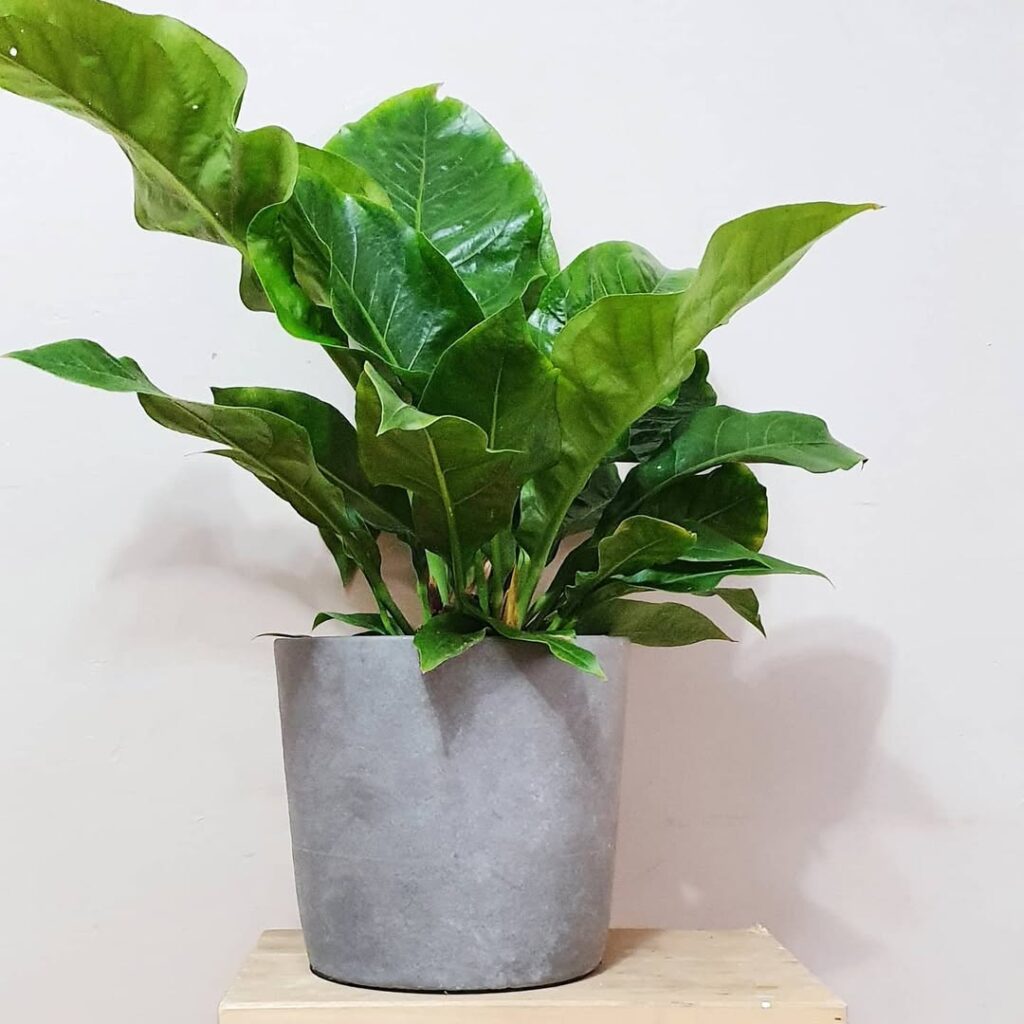
Anthurium Schlechtendalii, also known as the Giant Anthurium, has huge, elongated leaves that can grow several feet long.
33. Anthurium Carchiense
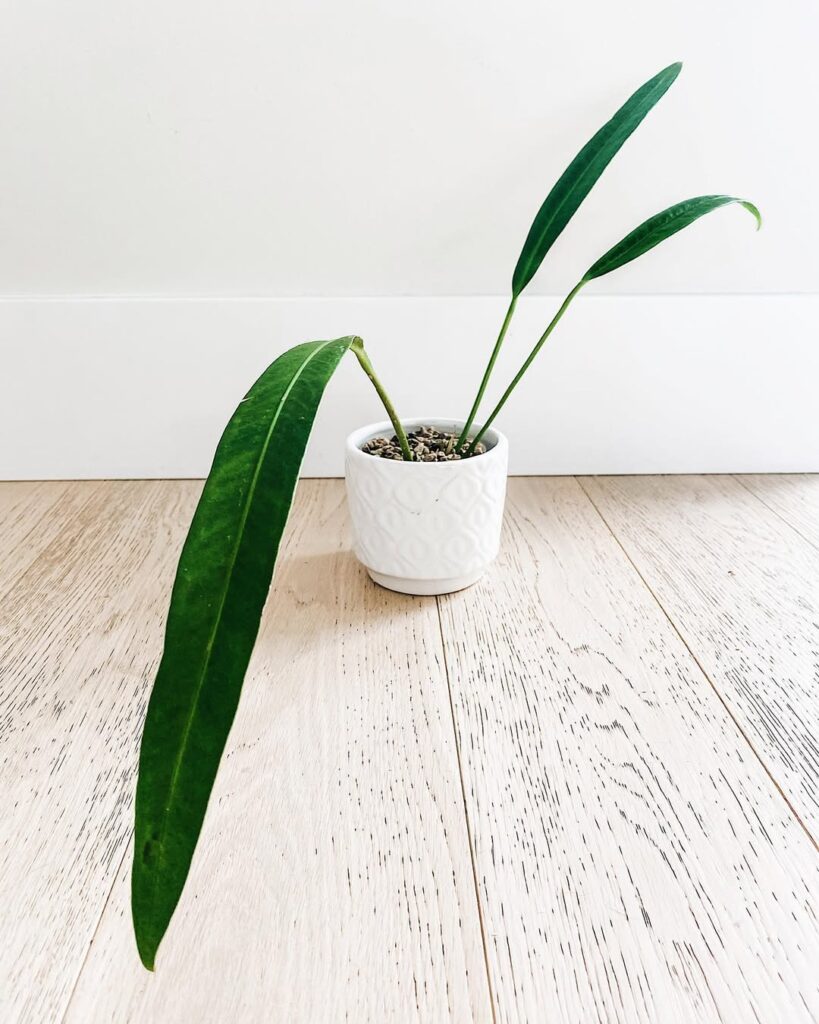
Anthurium Carchiense is a rare species with deeply veined, velvety leaves that give it an elegant, luxurious appearance.
34. Anthurium Faustomirandae
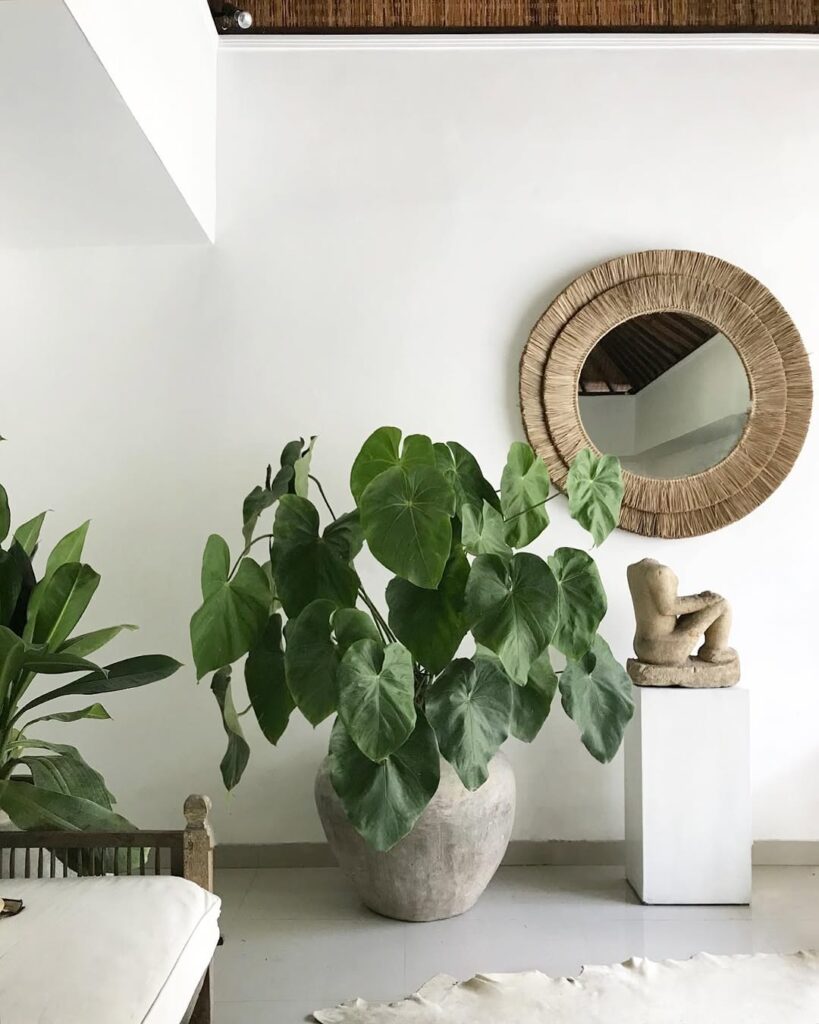
Anthurium Faustomirandae is a massive-leaved species, with thick, leathery foliage that can grow over three feet wide.
35. Anthurium Gracile
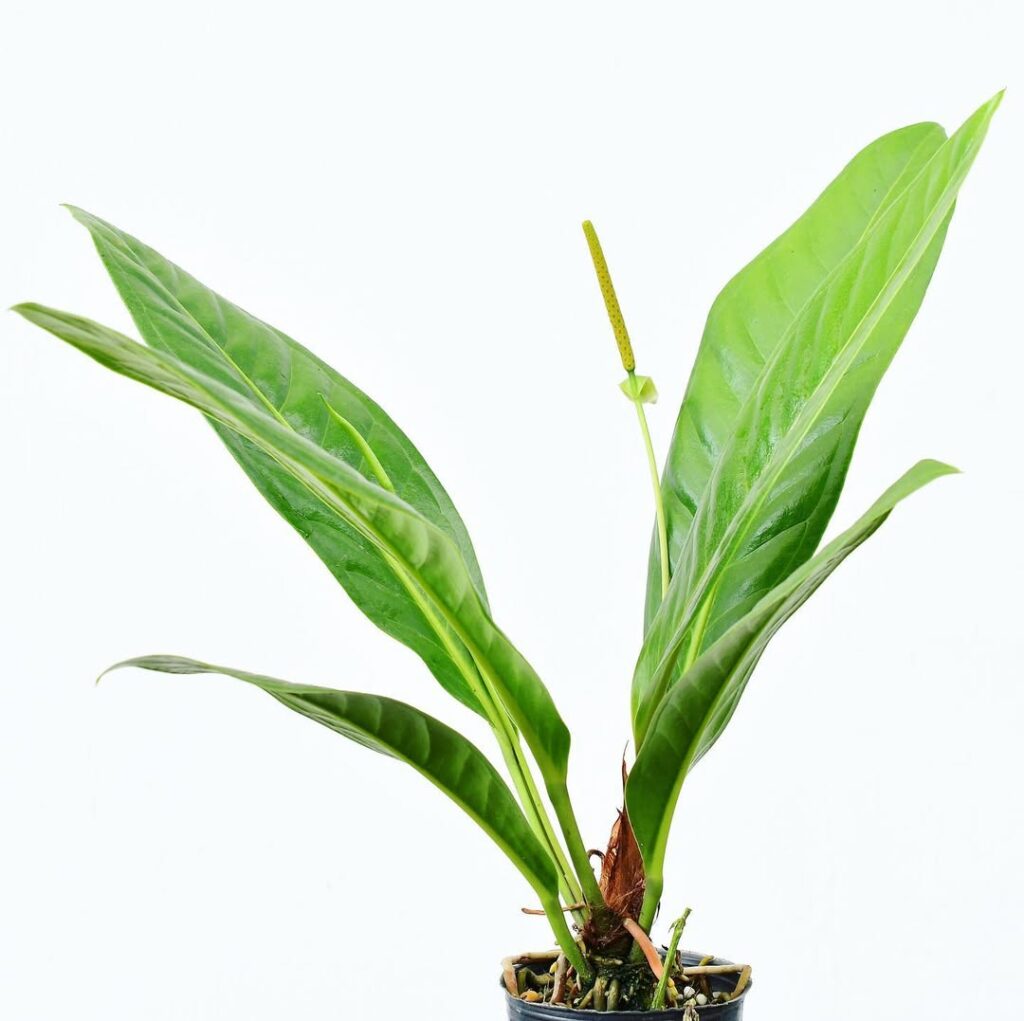
Anthurium Gracile is a delicate species with thin, elegant leaves that contrast beautifully with larger Anthuriums.
36. Anthurium Bonplandii
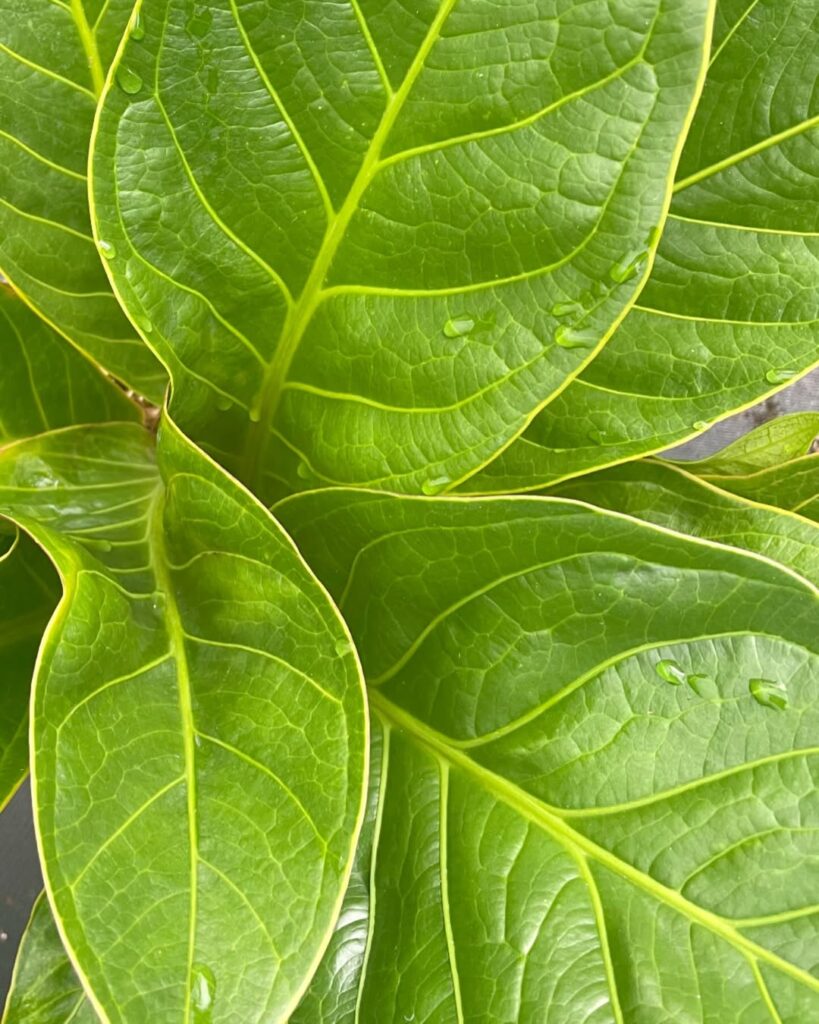
Anthurium Bonplandii has broad, stiff leaves with a leathery texture, making it a hardy indoor plant.
37. Anthurium Friedrichsthalii
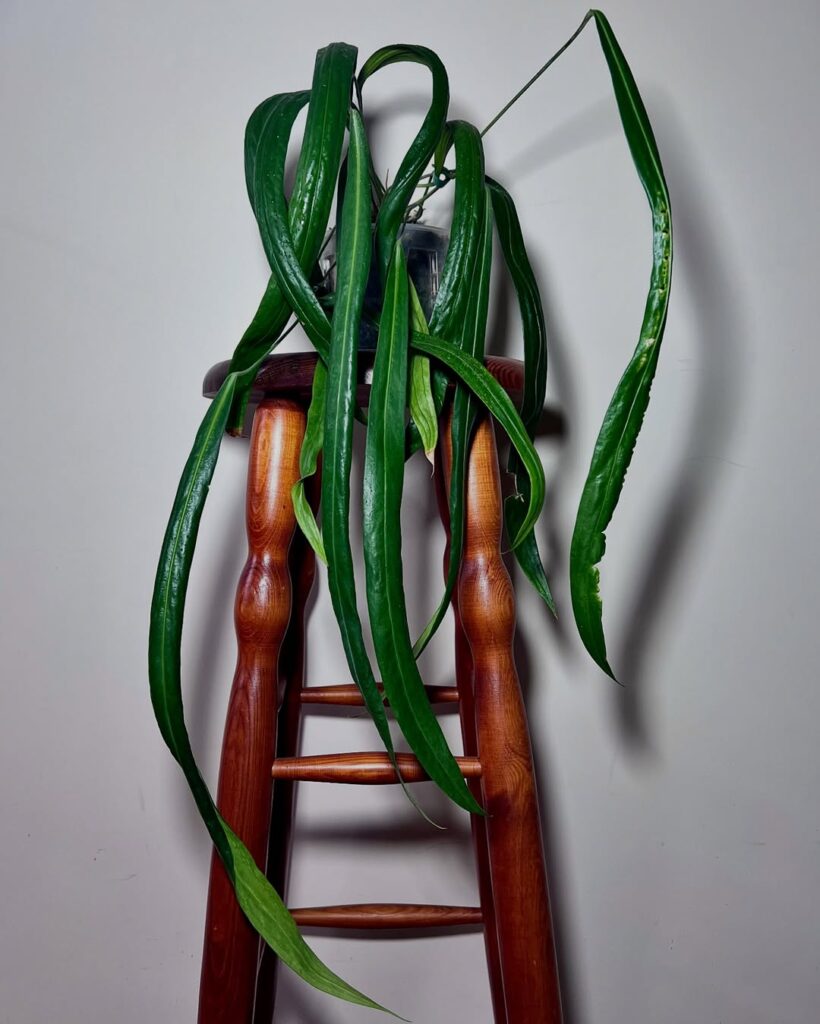
Anthurium Friedrichsthalii is known for its long, narrow leaves that drape elegantly, making it a great choice for vertical gardens.
38. Anthurium Villenaorum
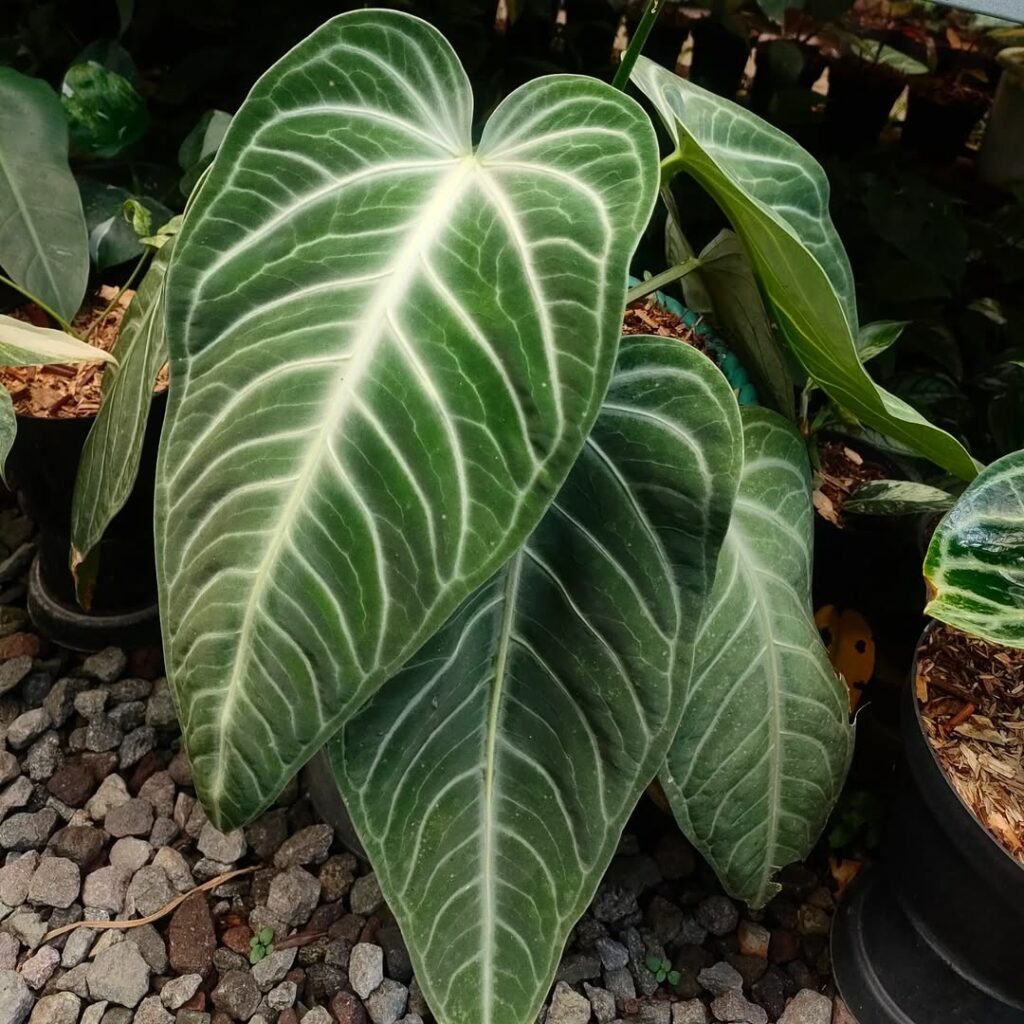
Anthurium Villenaorum has deeply veined leaves with a velvety texture, similar to Anthurium Clarinervium but with a more elongated shape.
39. Anthurium Podophyllum
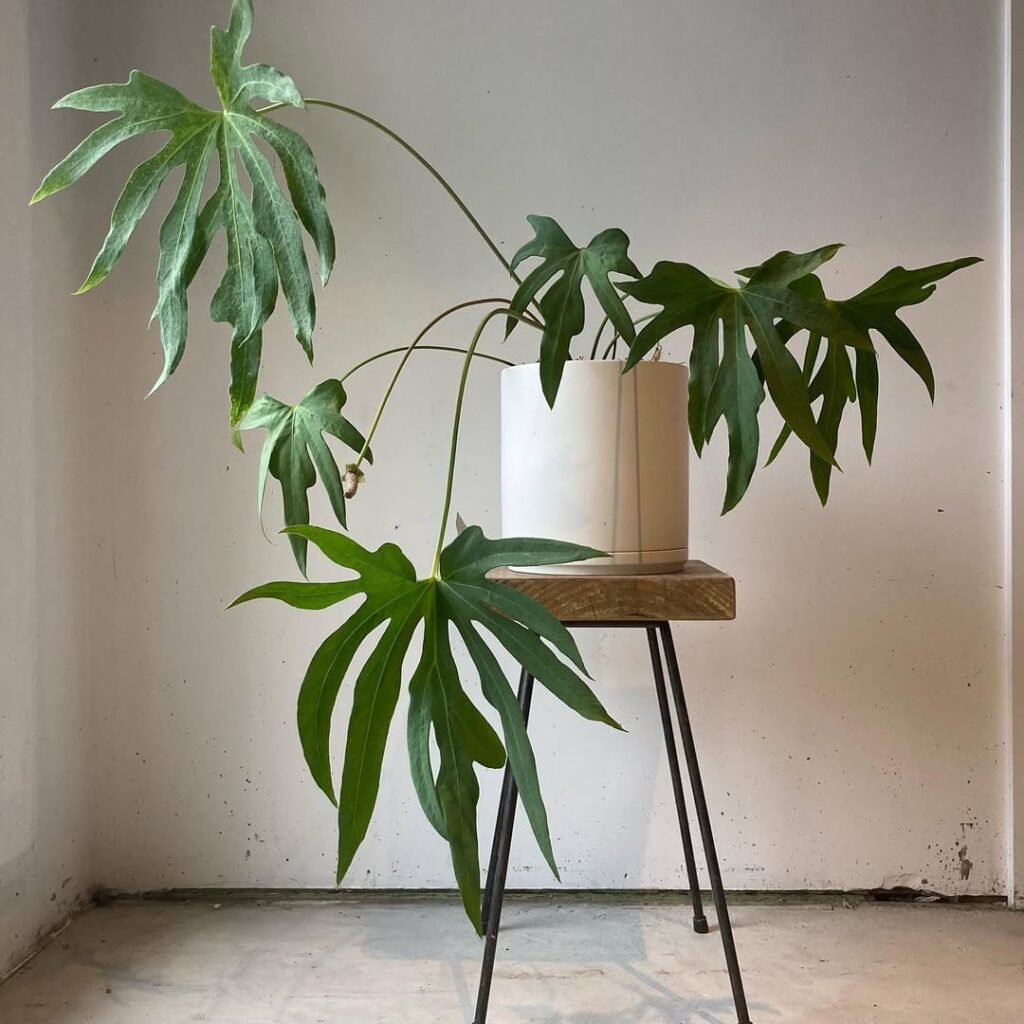
Anthurium Podophyllum has lobed leaves that resemble a star, making it one of the more unusual Anthurium varieties.
40. Anthurium Ovatifolium
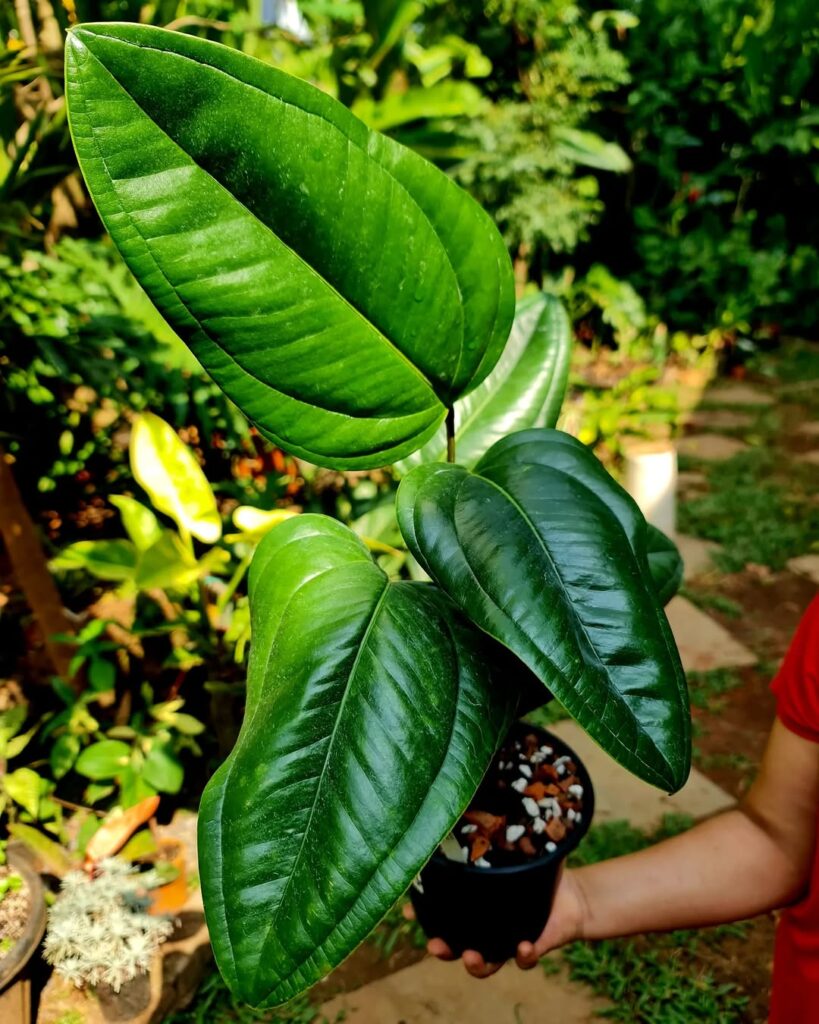
Anthurium Ovatifolium has oval-shaped leaves with a smooth, glossy finish, making it a great decorative plant.
41. Anthurium Rotundistigmatum
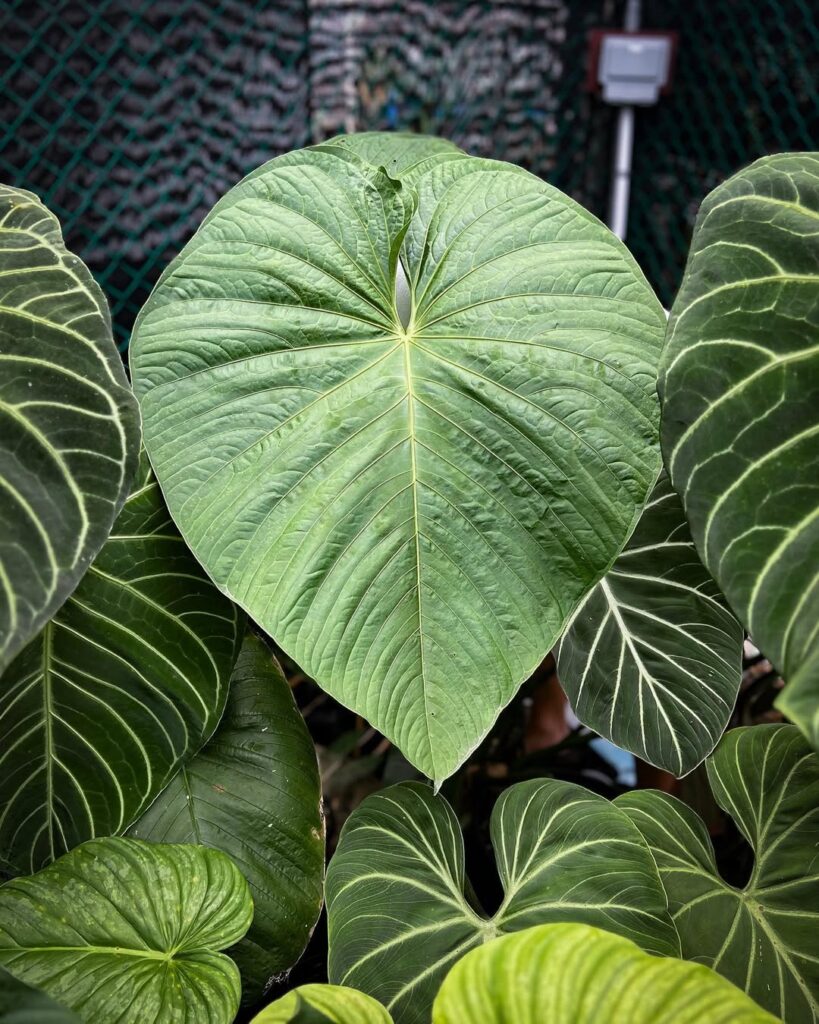
Anthurium Rotundistigmatum has rounded leaves with a unique texture, making it a rare and sought-after species.
42. Anthurium Clidemioides
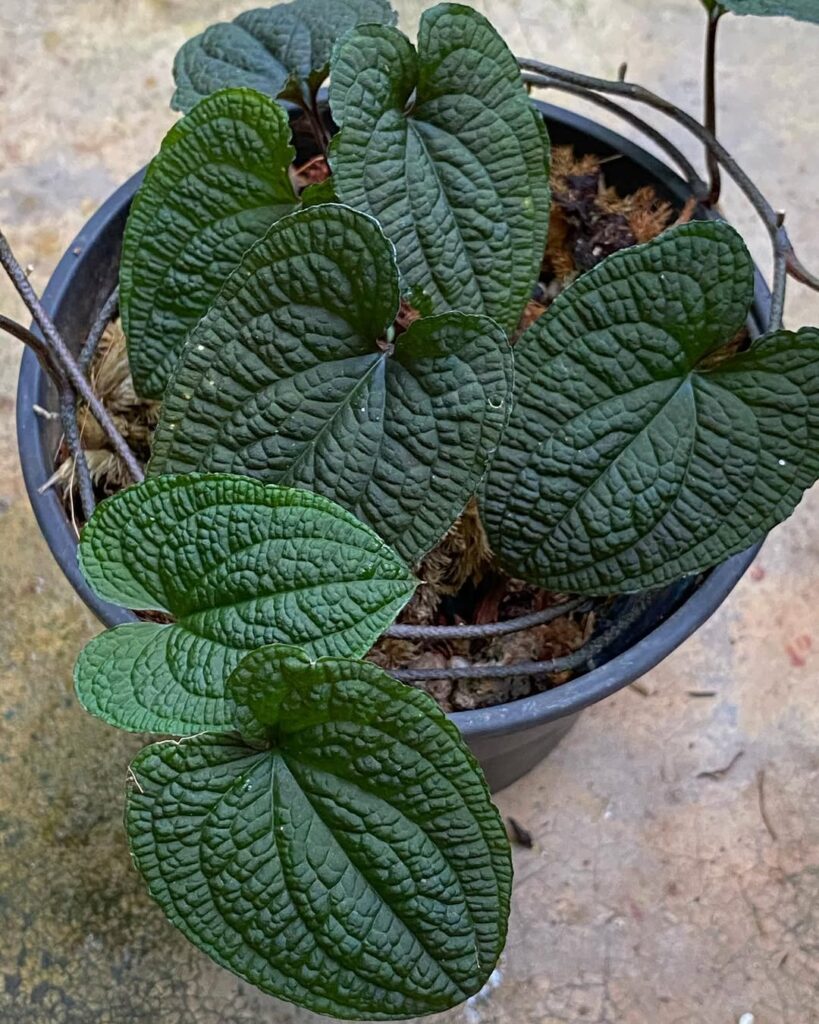
Anthurium Clidemioides has thin, elongated leaves with a delicate, airy appearance.
43. Anthurium Rotolantei
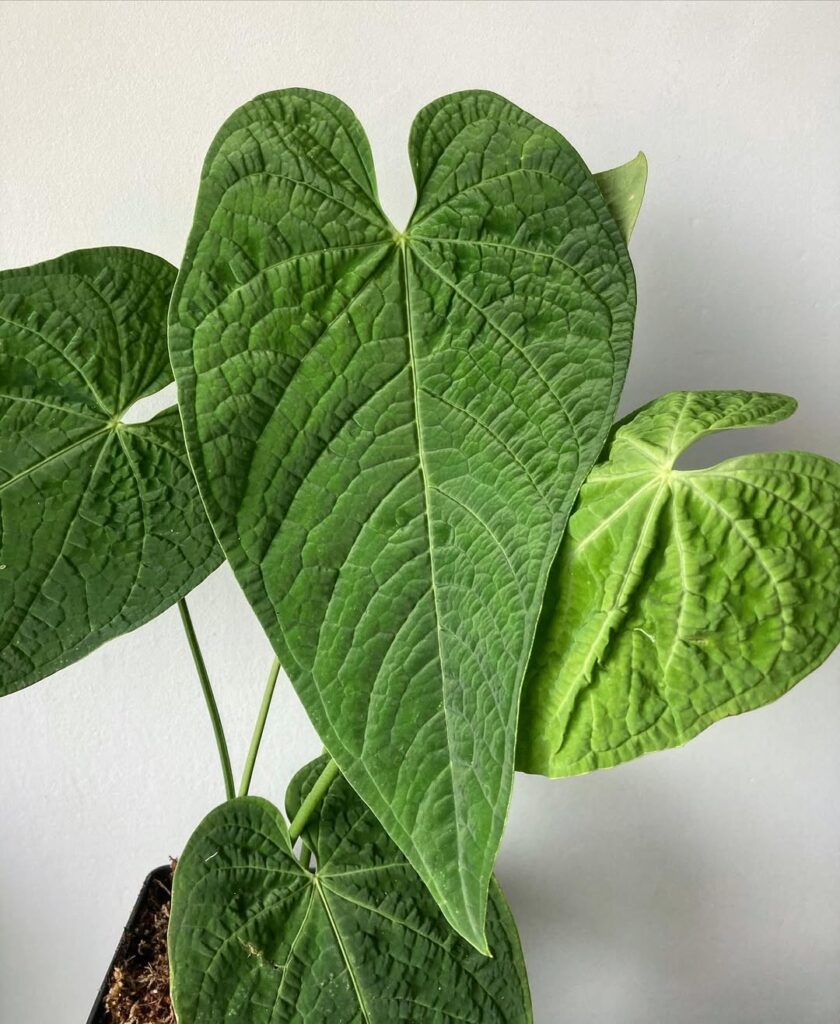
Anthurium Rotolantei features large, heart-shaped leaves with a rich, deep green color. The foliage has prominent, textured veins, creating an intricate and almost sculptural appearance.
44. Anthurium Pedatoradiatum
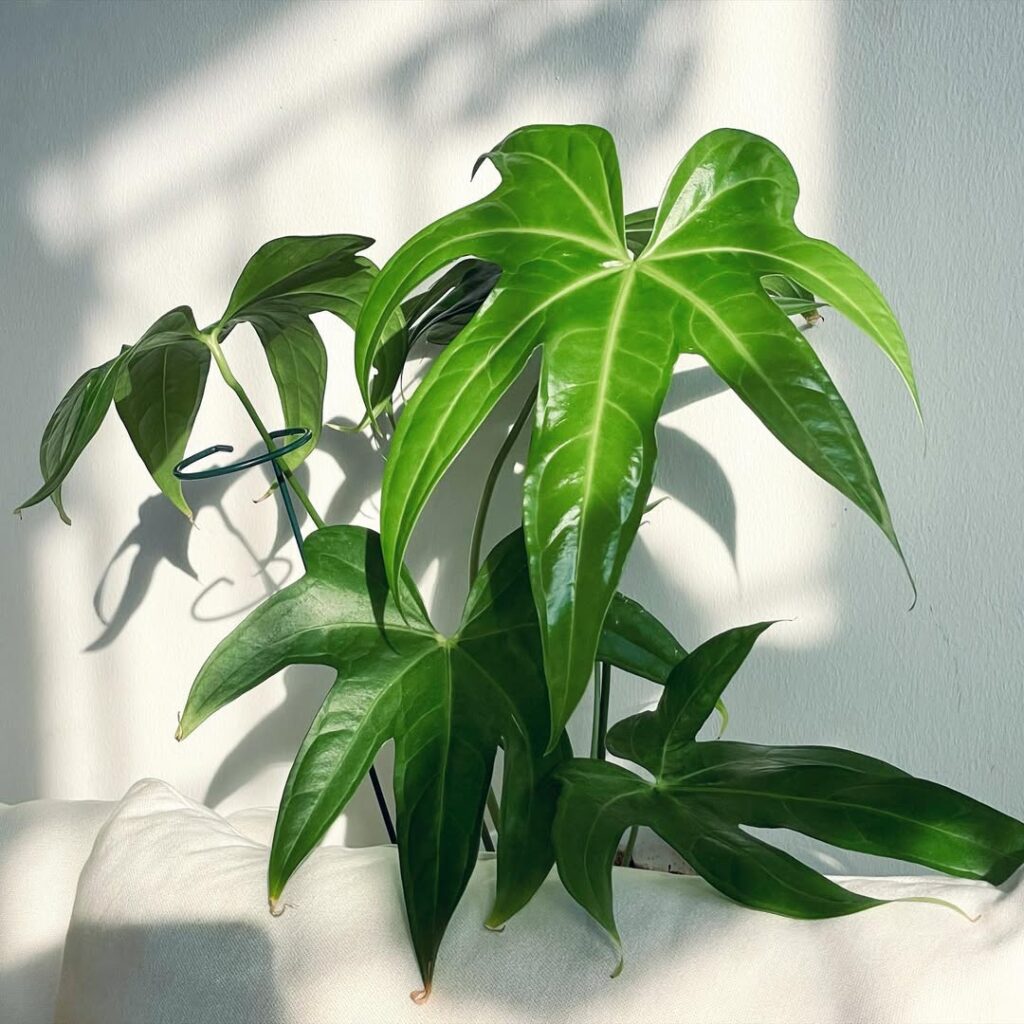
Anthurium Pedatoradiatum, also known as Finger Anthurium, has deeply lobed leaves that resemble fingers.
45. Anthurium Marmoratum
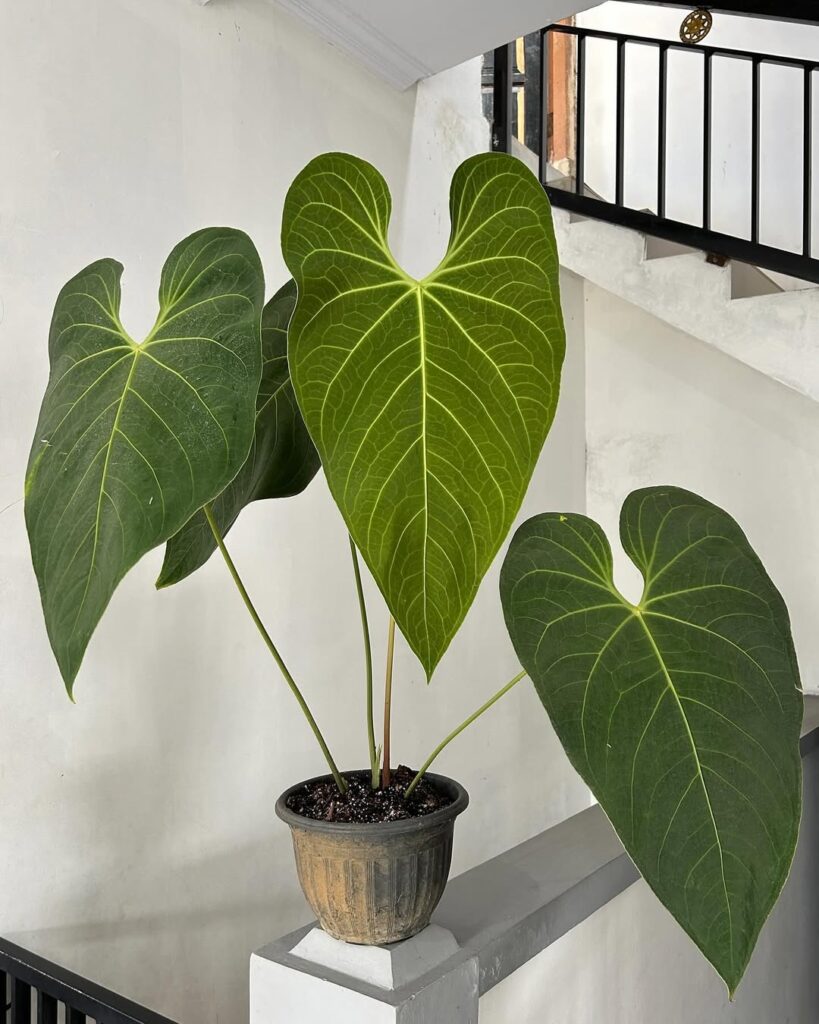
Anthurium Marmoratum has marbled leaves with intricate vein patterns, making it a visually stunning plant.
46. Anthurium Dark Mama
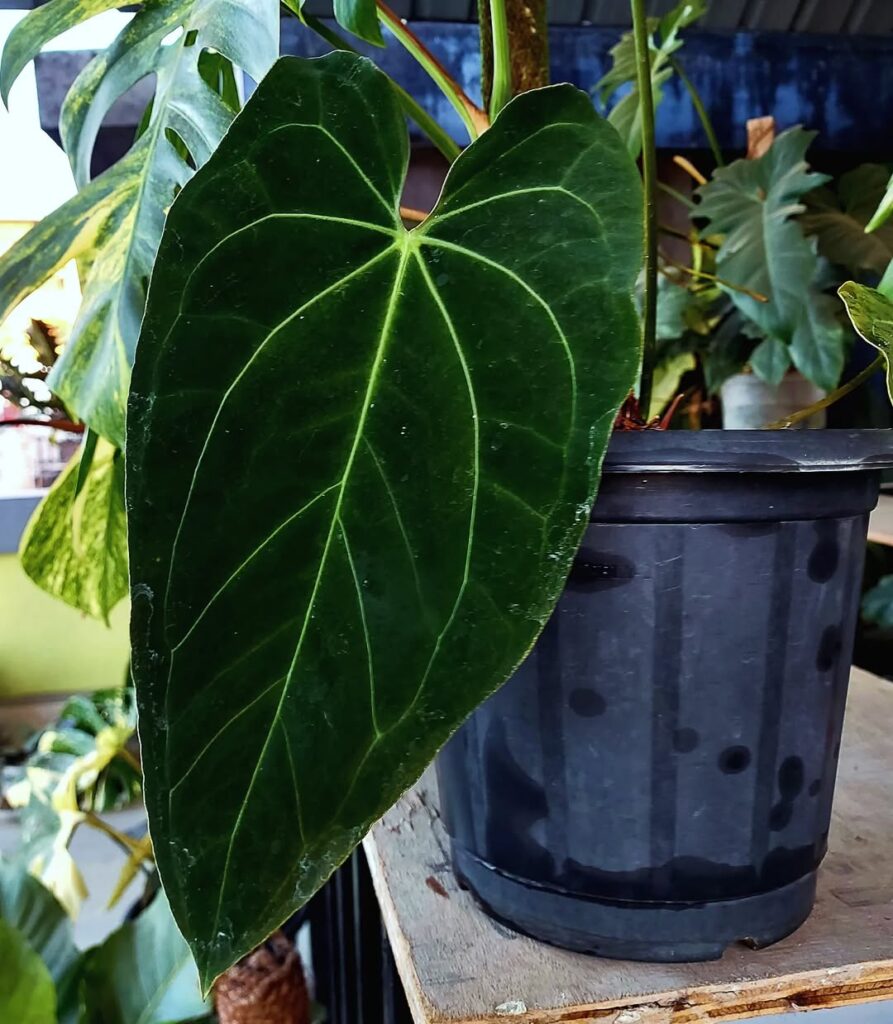
Anthurium Dark Mama is a hybrid variety, specifically a cross between Anthurium papillilaminum and Anthurium warocqueanum, with deep, dark green leaves that appear almost black.
47. Anthurium Coriaceum
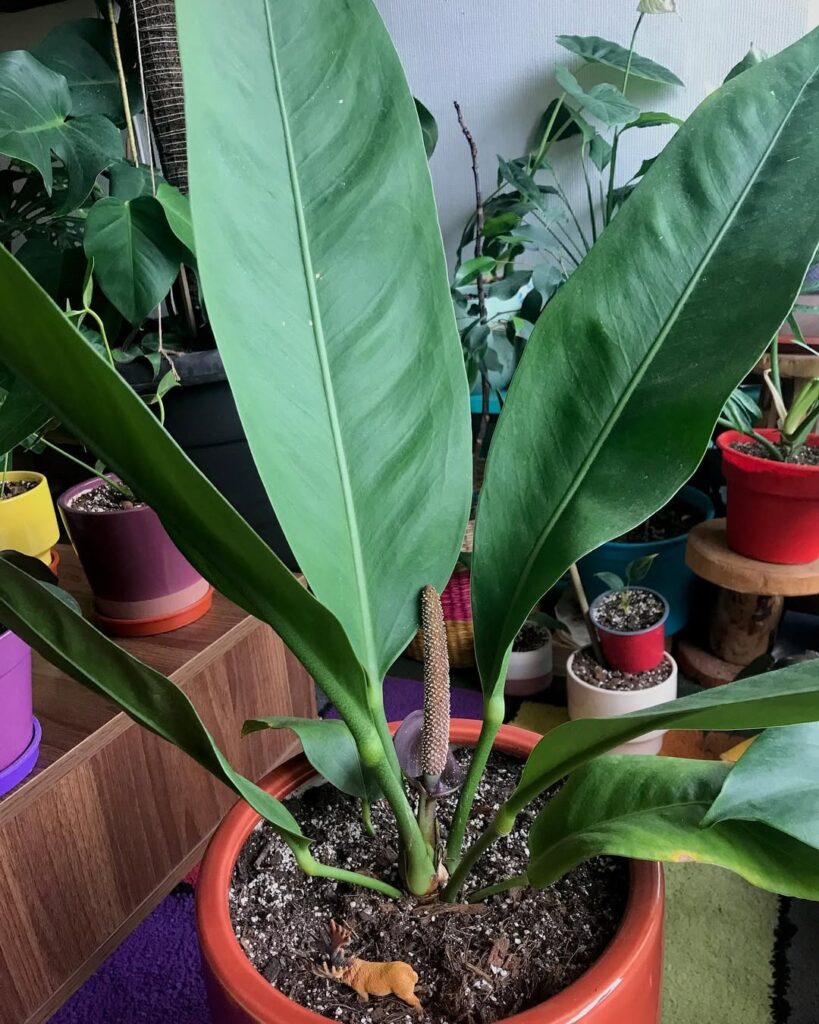
Anthurium Coriaceum has thick, leathery leaves that make it one of the more durable Anthurium species.
48. Anthurium Bakeri
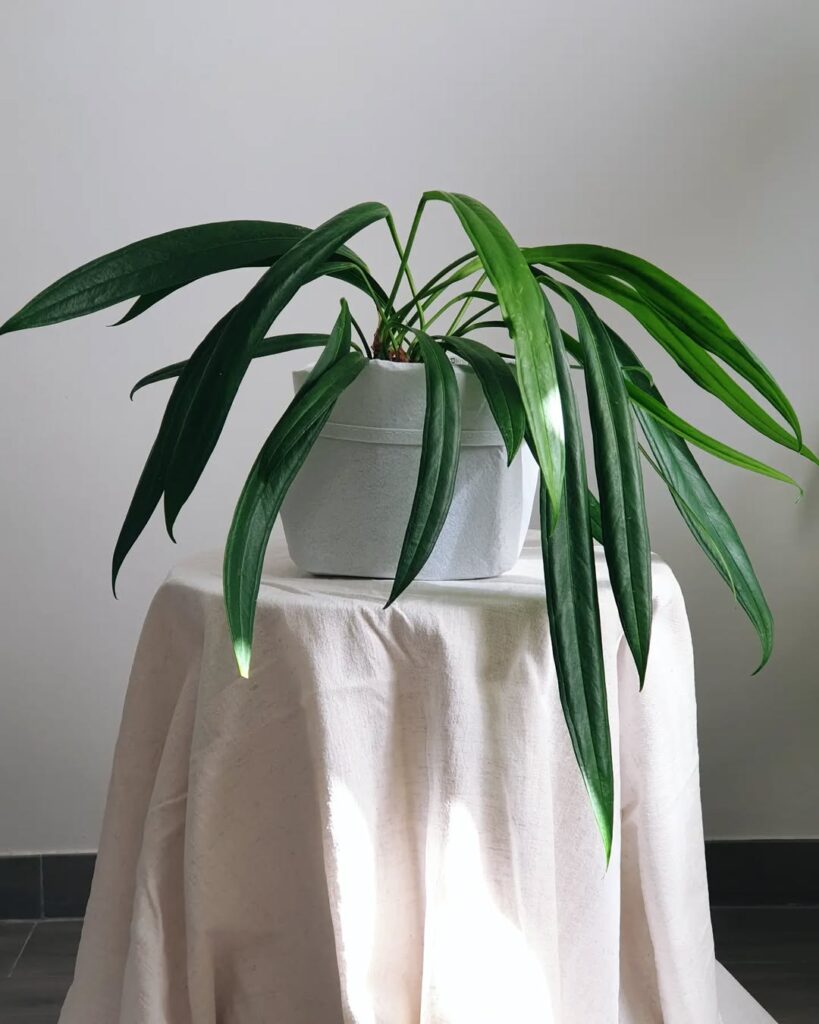
Anthurium Bakeri is a compact variety with thin, strap-like leaves that grow in an elegant cascading fashion, making it an excellent plant for tight spaces.
49. Anthurium Besseae
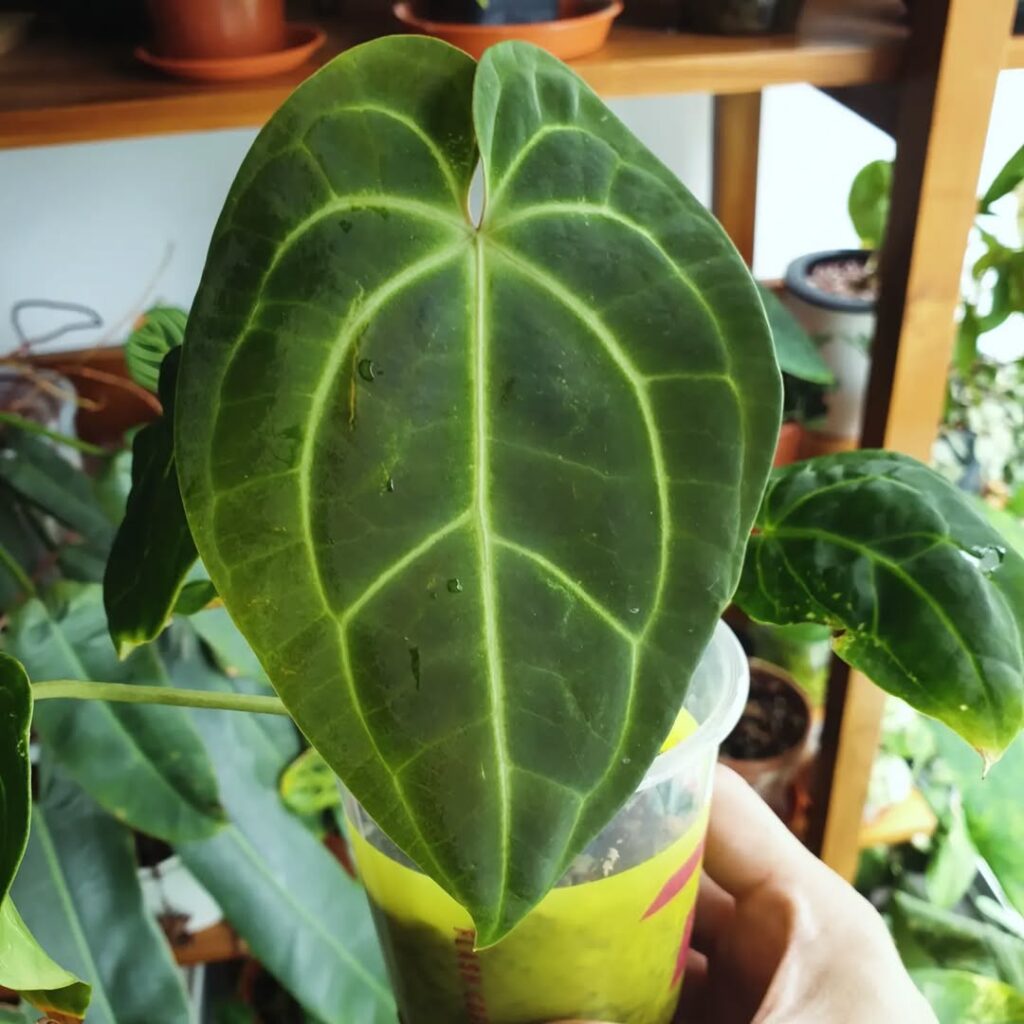
Anthurium Besseae showcases large, heart-shaped leaves with a deep green color and striking bright green veins that create a bold contrast. The glossy texture of the foliage enhances its visual appeal, making it a highly sought-after species.
50. Anthurium Besseae aff
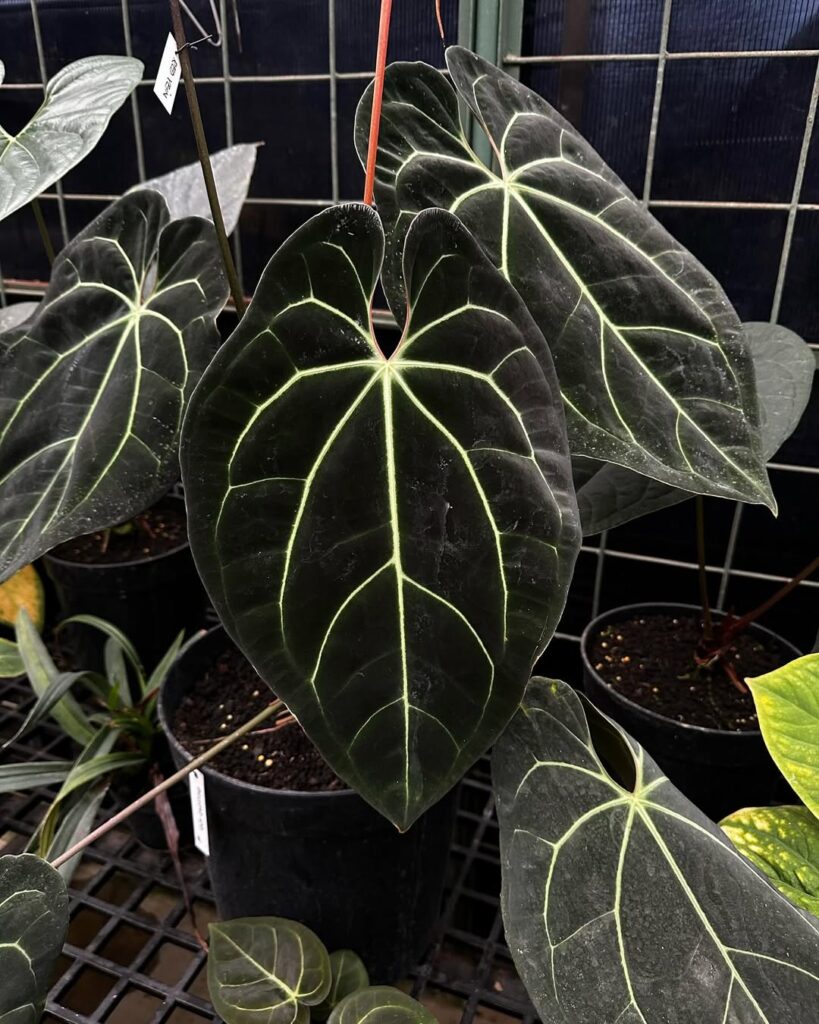
Anthurium Besseae aff is a unique variation of Anthurium Besseae that differs significantly in appearance. Unlike the true Besseae, this plant has dark, crystallinum-like foliage with a velvety texture and prominent veins. It is often considered a showstopper due to its rich coloration and striking leaf structure.
51. Anthurium Lancifolium
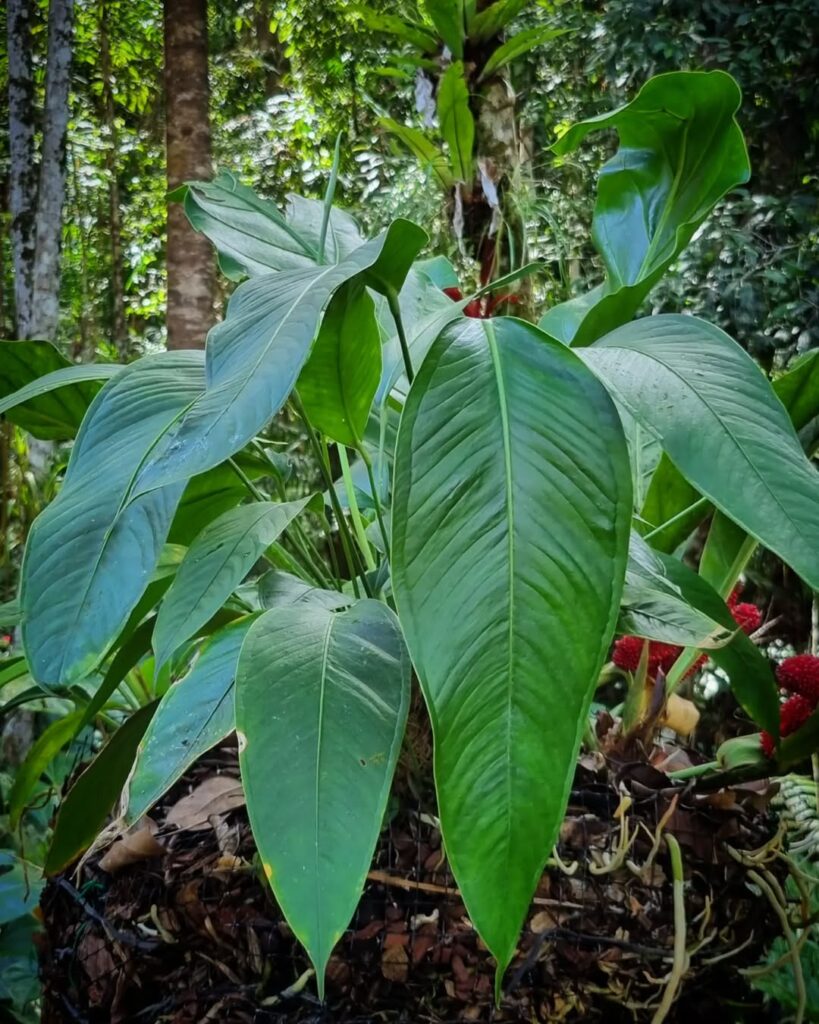
Anthurium Lancifolium has long, sword-shaped leaves, giving it a tropical rainforest vibe. It’s a low-maintenance species that can thrive in typical household humidity.
52. Anthurium Scandens
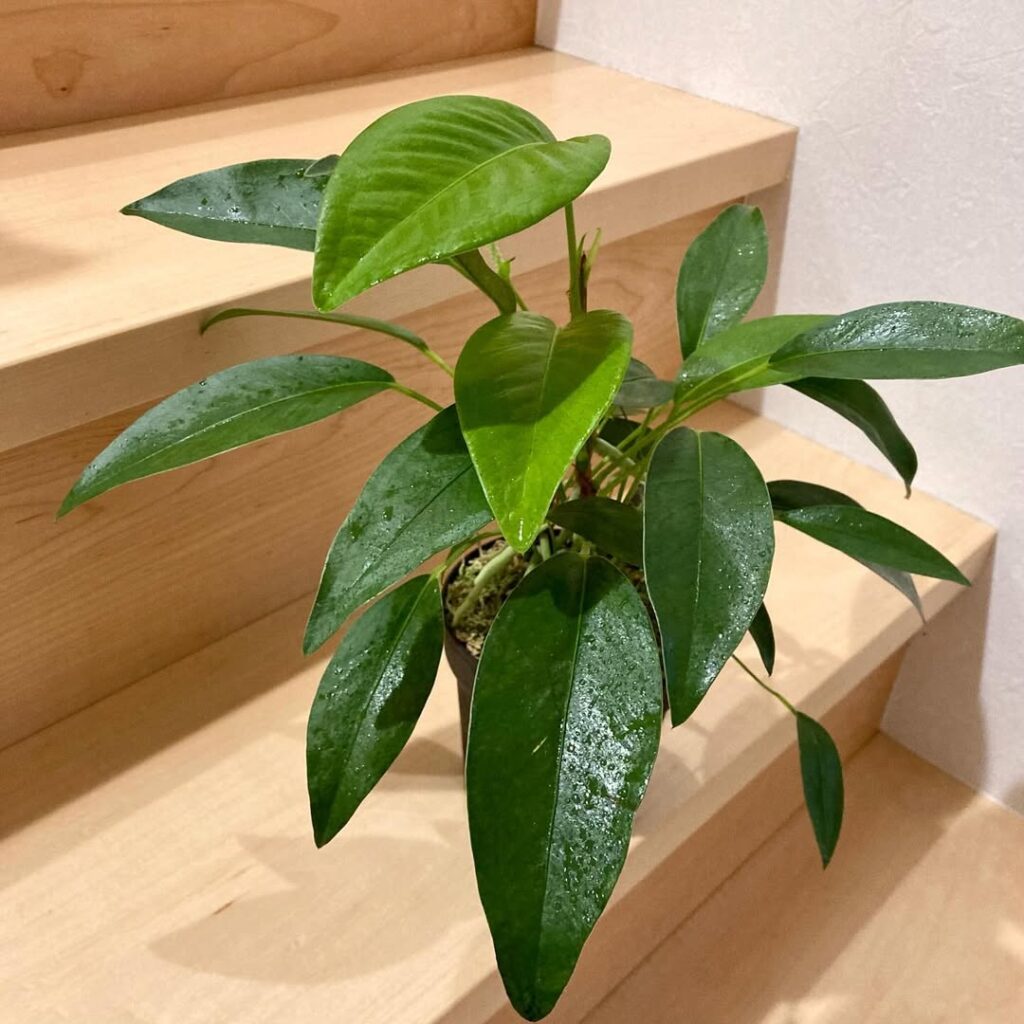
Anthurium Scandens is a vining Anthurium, meaning it climbs rather than grows upright. It produces small, delicate flowers and loves to drape over containers.
53. Anthurium Argyrophyllum
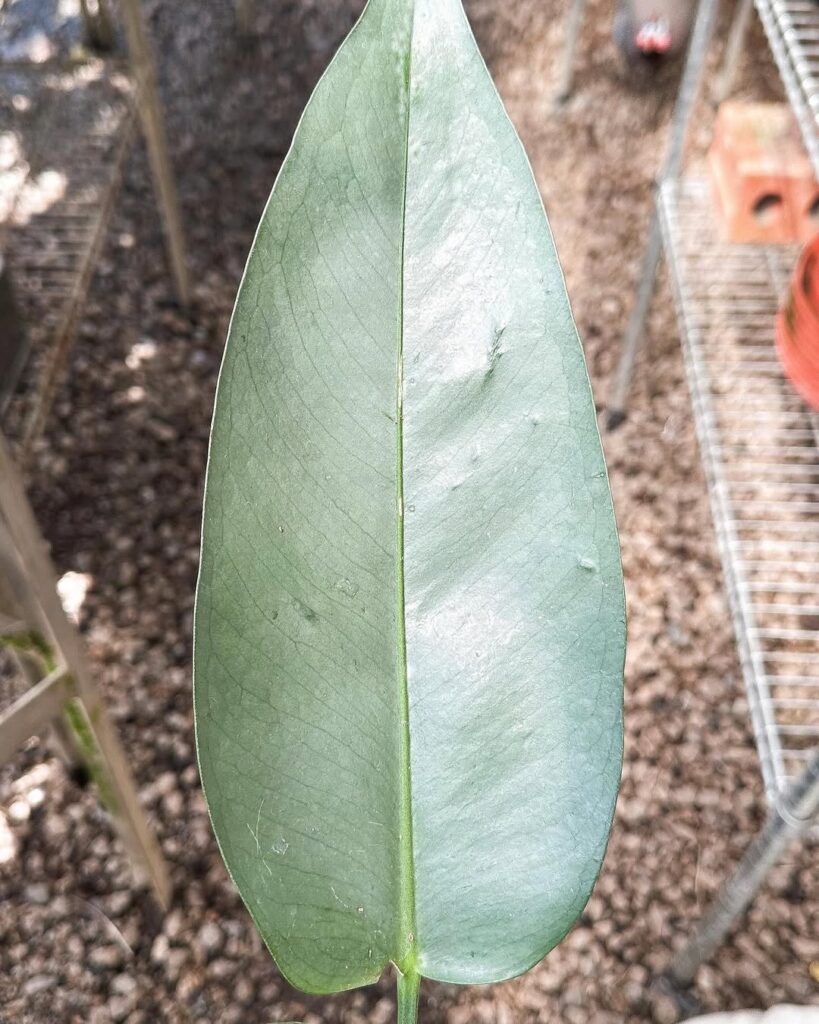
Anthurium Argyrophyllum has metallic silver leaves that remain reflective from emergence to maturity. Its elongated, smooth-textured foliage features a central vein, creating a sleek and shimmering effect.
54. Anthurium Crenatum
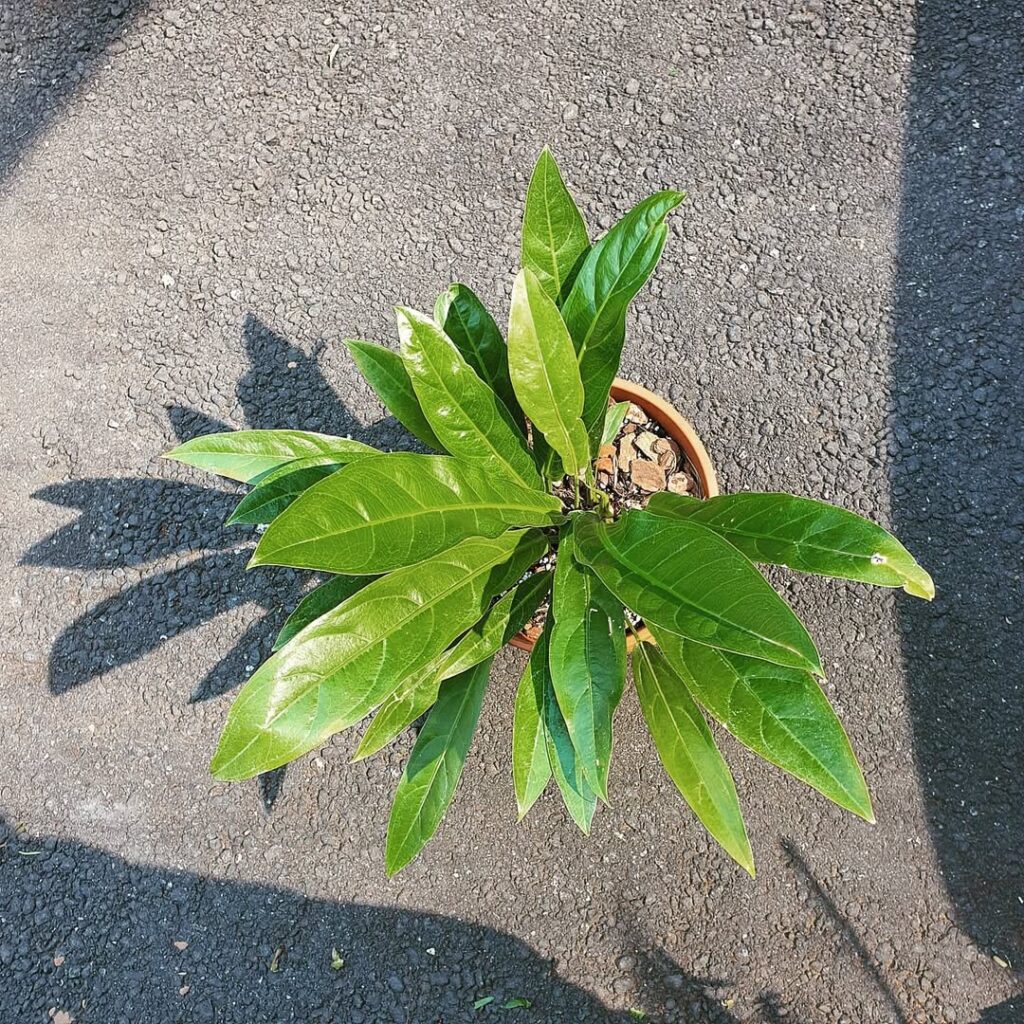
Anthurium Crenatum has broad, glossy green leaves with slightly wavy edges that form a rosette-like shape.
55. Anthurium Leuconeurum

Anthurium Leuconeurum showcases bright white veins against its deep green leaves, making it a standout species for foliage lovers.
56. Anthurium Hoffmannii
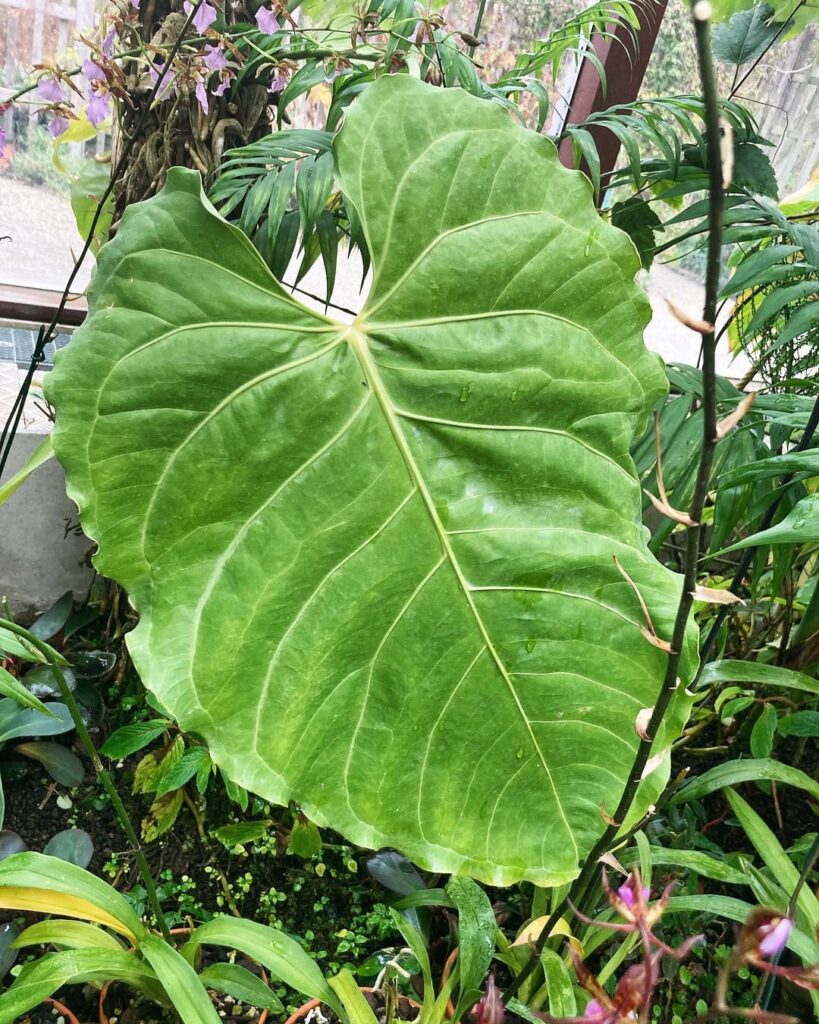
Anthurium Hoffmannii has large, heart-shaped leaves with prominent veins and a smooth, glossy texture, adding to its tropical appeal.
57. Anthurium Hoffmannii ‘Red Sinus’
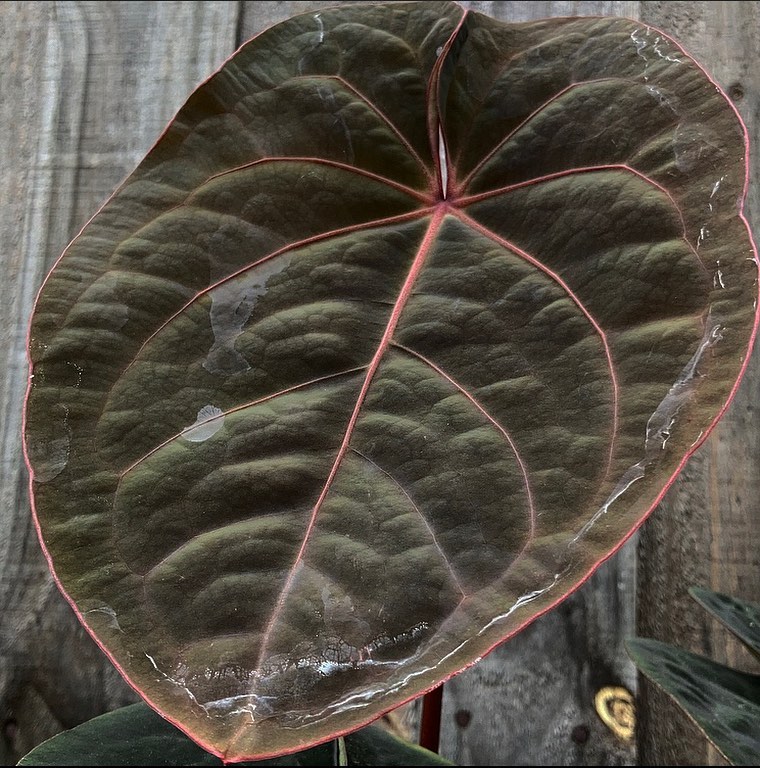
Anthurium Hoffmannii ‘Red Sinus’ has large, heart-shaped leaves with a dark green base and striking red veins that create a bold contrast. The glossy surface enhances its vibrant coloration.
58. Anthurium Hoffmannii ‘King of Spades’
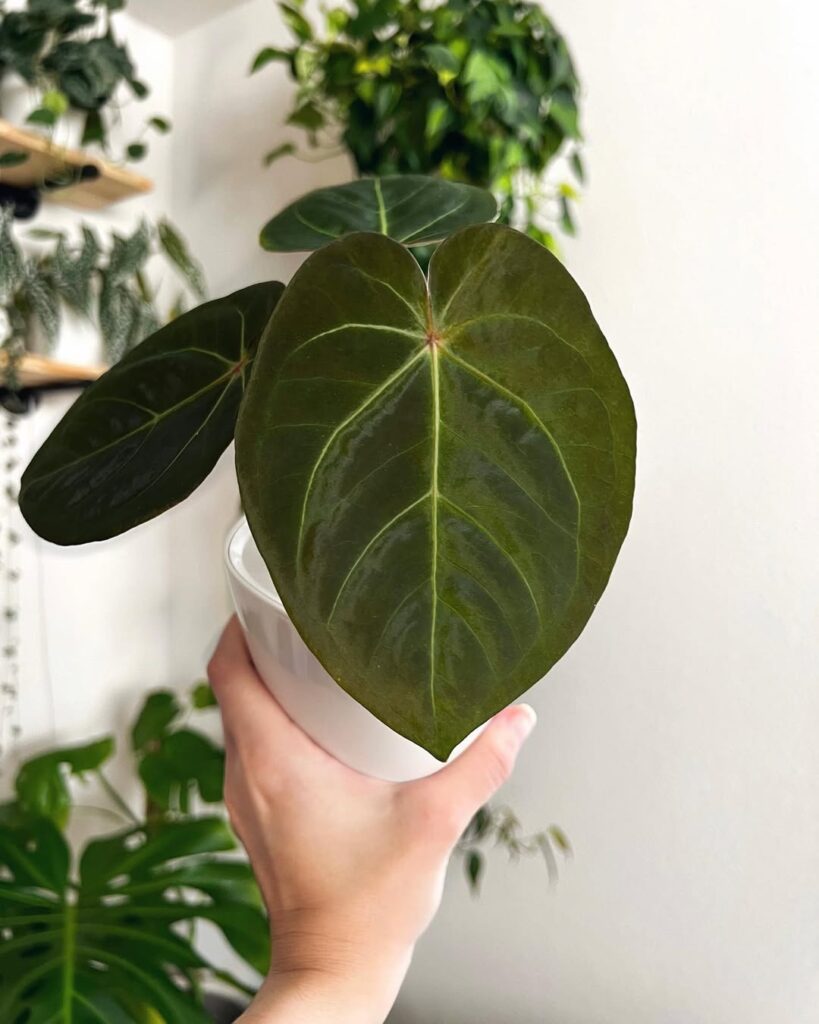
Anthurium Hoffmannii ‘King of Spades’ features large, heart-shaped leaves with dark green coloration and contrasting bright veins. The foliage has a velvety texture, enhancing its regal appearance.
59. Anthurium Truncicola
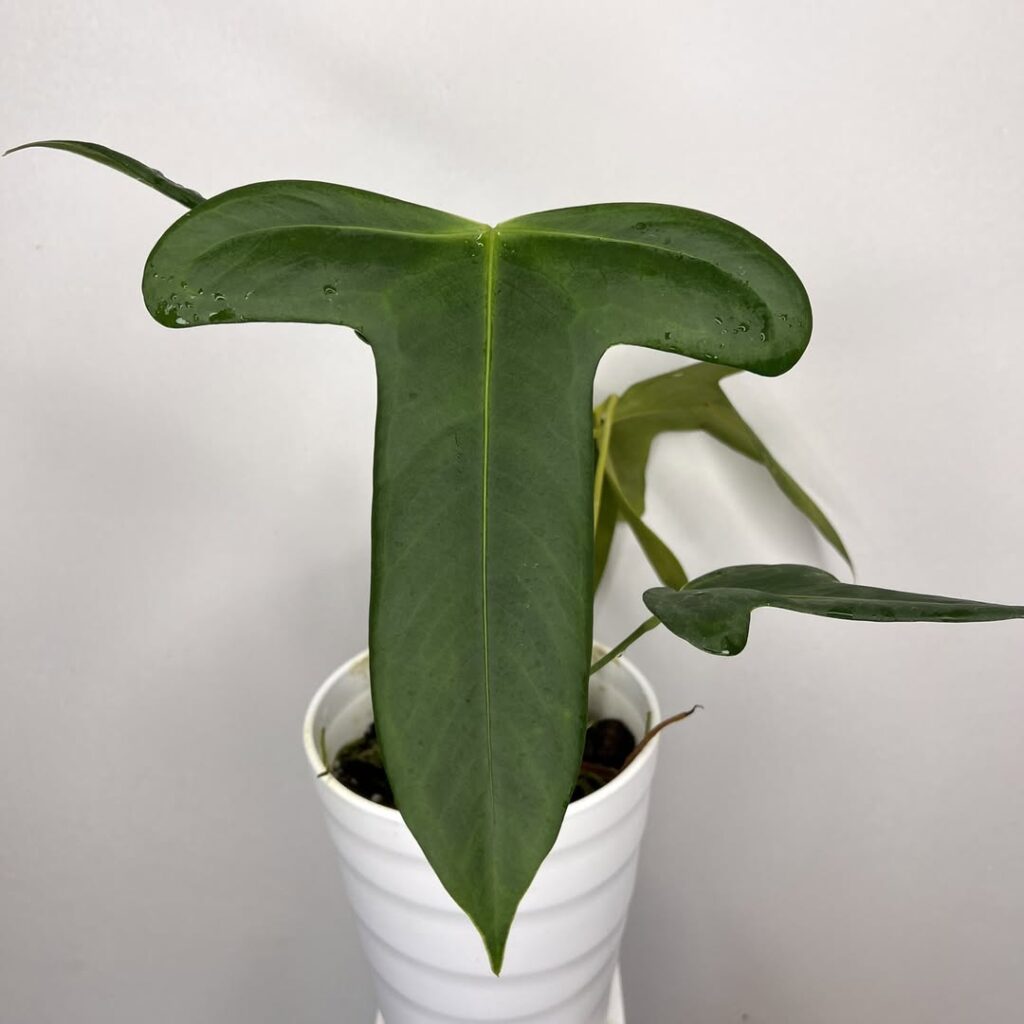
Anthurium Truncicola features elongated, trilobed leaves with a prominent central vein and slightly textured surface. The foliage is dark green, semi-glossy, and has a distinctive T-shaped structure, making it stand out among Anthurium species.
60. Anthurium Peltigerum
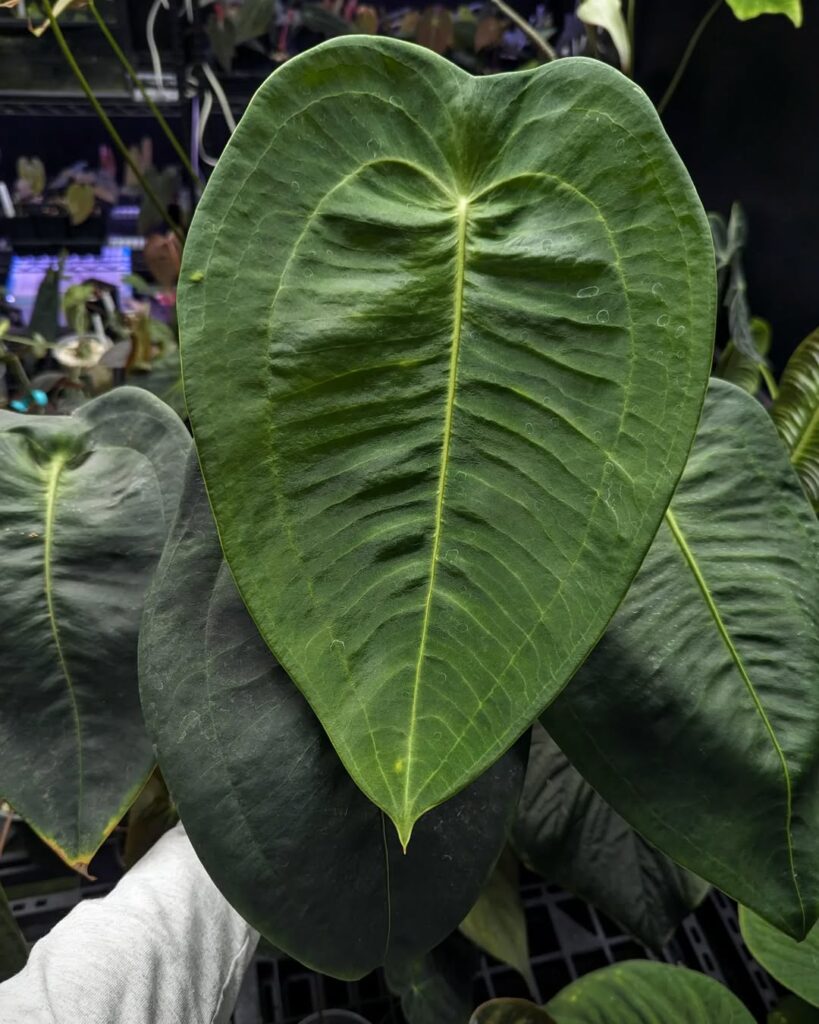
Anthurium Peltigerum features large, heart-shaped leaves with a smooth, glossy texture and prominent veins. Its foliage is peltate, meaning the petiole attaches directly to the leaf blade, making it one of only a few Anthurium species with this trait. The leaves resemble a turtle shell, with parallel tertiary veins adding to its unique appearance.
61. Anthurium Delta Force
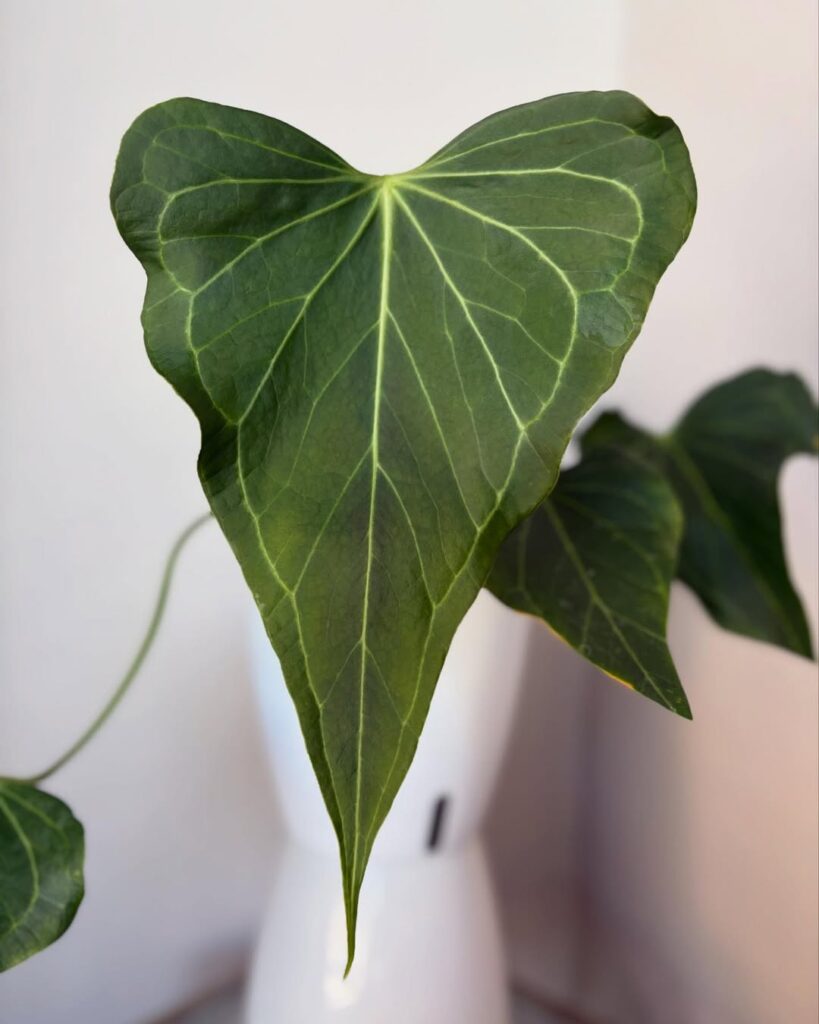
Anthurium Delta Force features large, heart-shaped leaves with deep green coloration and prominent, lighter veins that create a striking contrast. The foliage has a slightly velvety sheen, adding texture and depth to its appearance. Mature leaves may develop a subtle rippling effect along the edges, enhancing their architectural beauty.
